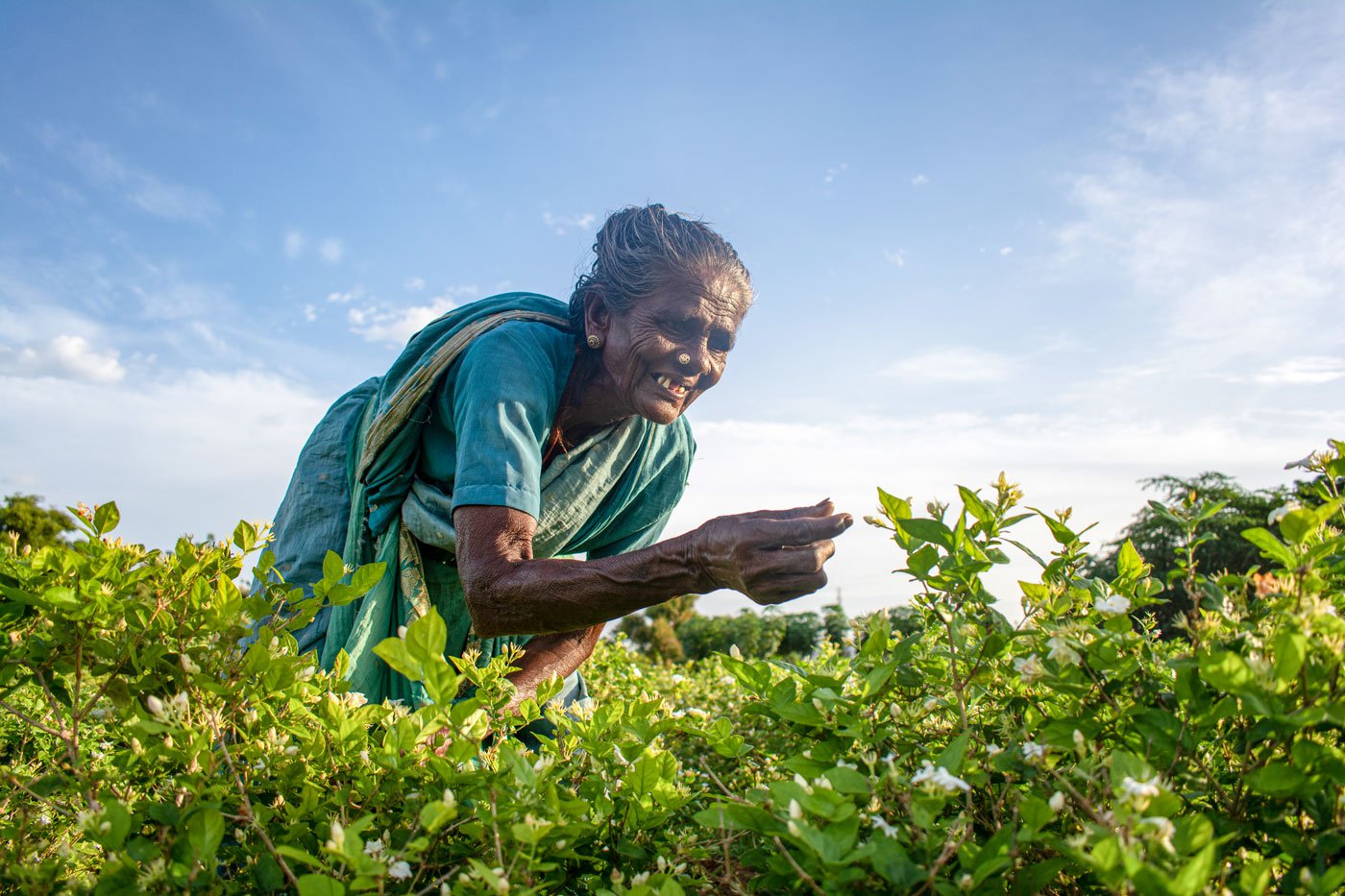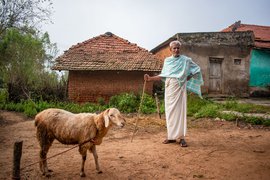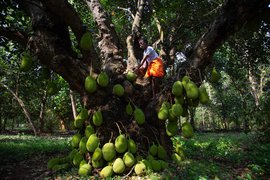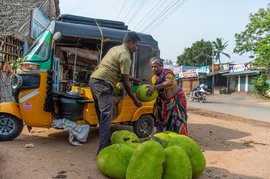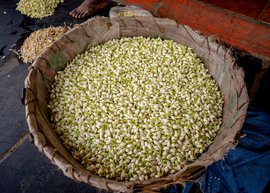It’s no bigger than a fingernail, and each bud is pale, white, and pretty. Here and there, the field glints with fully opened blossoms, their heady fragrance filling the nostrils. The jasmine flower is a gift. Of the dusty earth, stout plants, and a sky bruised with clouds.
But the workers here have no time to romance its nostalgic appeal. They need to get the malli (jasmine) to the pookadai (flower market) before it blooms. It’s four days to Vinayaka Chathurthi , Lord Ganesha’s birthday, which means you can hope for good rates.
Using only their thumbs and fore-fingers, the men and women quickly snap the buds. They drop handfuls into a twist of their sarees or dhotis fashioned into a pouch and empty it later into sacks. There’s a precision to the work: move the branch (rustle, rustle), pluck the buds (snap, snap, snap), walk to the next plant, as tall as a three-year-old child, pick more flowers, and chat. Also, listen to popular Tamil songs on the radio, while the sun comes up slowly over the eastern sky…
Soon, the flowers will reach Mattuthavani market in Madurai city, and from there go on to other towns in Tamil Nadu. And sometimes, over the high seas to other nations.
PARI visited Thirumangalam and Usilampatti taluks in Madurai district in 2021, 2022 and 2023. The jasmine fields are less than an hour’s drive from Madurai city – with its iconic Meenakshi Amman temple and bustling flower market – where malli is sold by the handful and in heaps.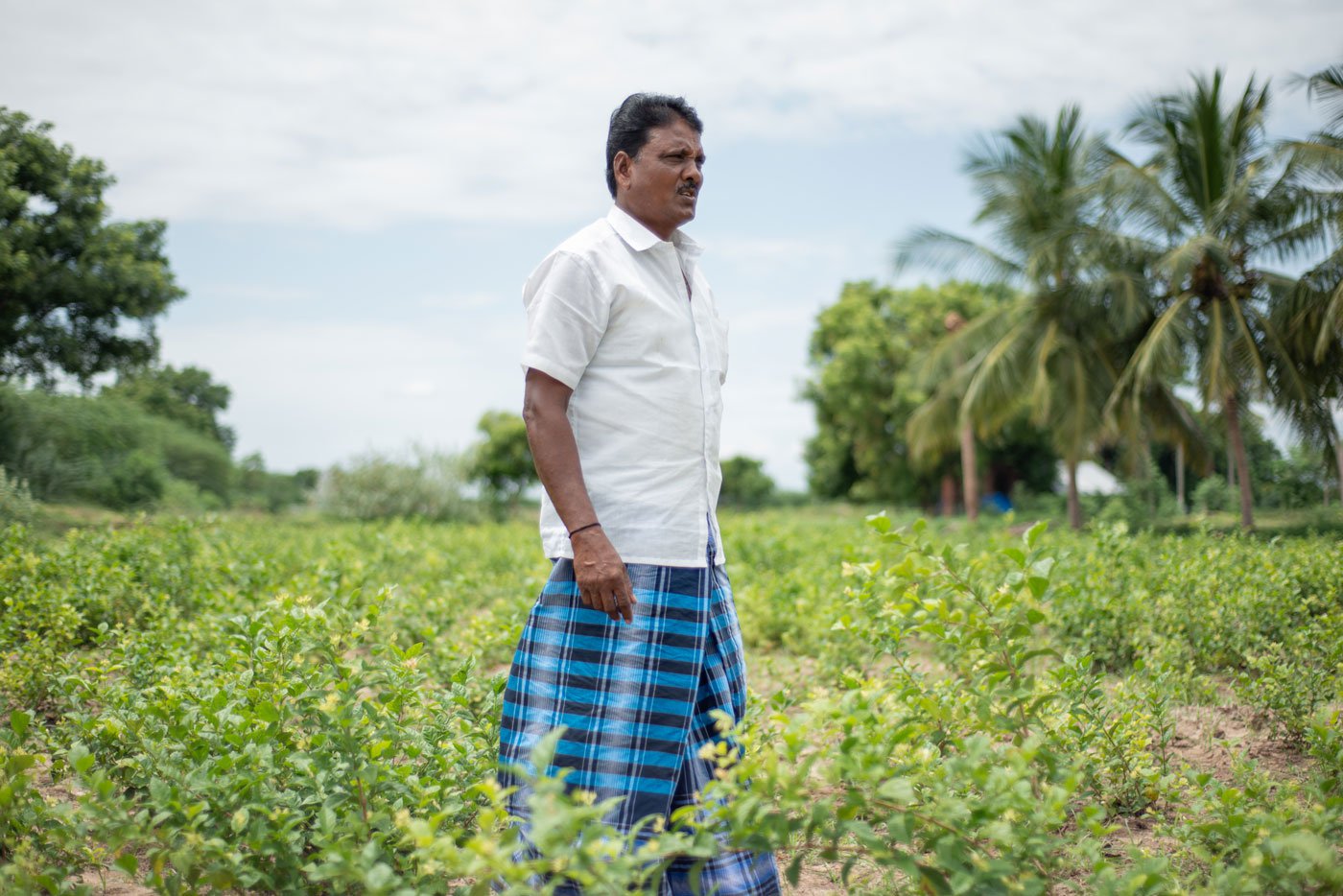
Ganapathy standing in the middle of his fields in Melauppiligundu, a hamlet in Thirumangalam taluk of Madurai. The jasmine plants have just had their peak flowering and now there is only about a kilo to be plucked everyday
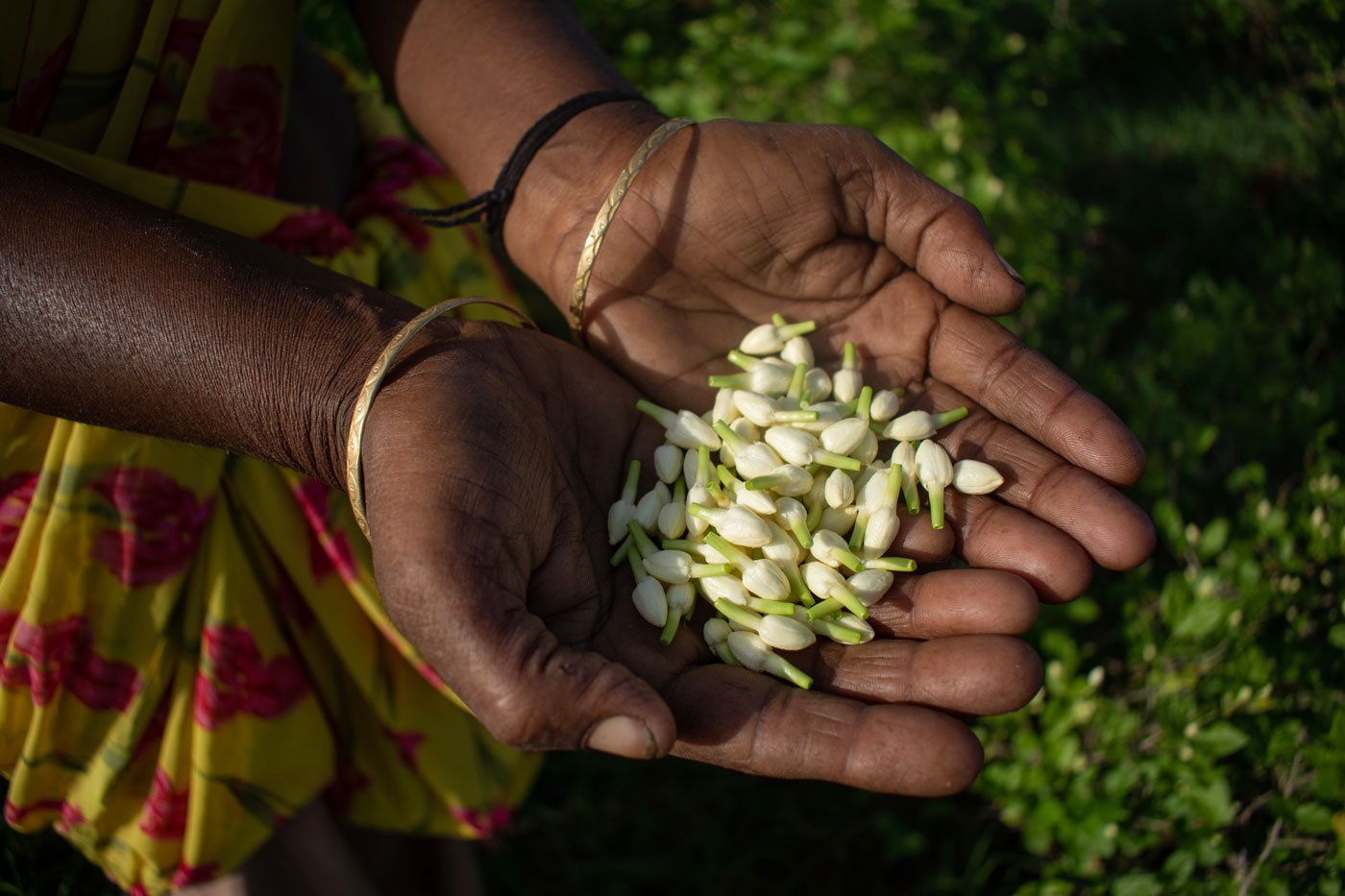
A handful of fragrant jasmine buds
P. Ganapathy, 51, Melauppiligundu hamlet, Thirumangalam taluk , gives me an overview of the flower that takes – and lends its name to the Madurai region. “This area is famous for its fragrant malli . Why, you just need to keep half a kilogram of jasmine inside your house, the smell will linger for a week!”
In a spotless white shirt – with some rupee notes tucked into his pocket – and a blue lungi, Ganapathy smiles easily, and speaks in rapid Madurai Tamil. “Until it is a year old, the plant is like a baby,” he explains “and you have to look after it carefully.” He owns two and a half acres, on one of which he grows jasmine.
The plant begins to flower in around six months, but it isn’t evenly paced. Like the price for one kilogram of jasmine, it goes up and down. Sometimes, Ganapathy gets barely a kilo from an acre. A couple of weeks later, that might jump to 50 kilos. “During the wedding and festival season, the rates are very good: one thousand, two thousand, three thousand rupees…all for a kilo of jasmine. But when everybody’s plants are thick with flowers – even if it is peak season – the rate is going to be poor.” There are no guarantees in farming. The only thing that is assured is the expense.
And, of course, labour. Some mornings, he and his veetukaramma – as Ganapathy refers to his wife Pichaiyamma – have plucked up to eight kilos of flower. “Our backs would hurt,” he says, “very badly.” What hurts him more are the escalating costs – of fertiliser and pesticide, labour charges, and fuel. “How can we see a decent profit?” That was in September 2021.
This everyday flower – common in every street corner, emblematic of Tamil culture; malli , synonymous with a city, a kind of idli , a rice variety; jasmine, that scents every temple, wedding and market, the familiar smell in every crowd, bus and bedroom – is not easy to raise…*****
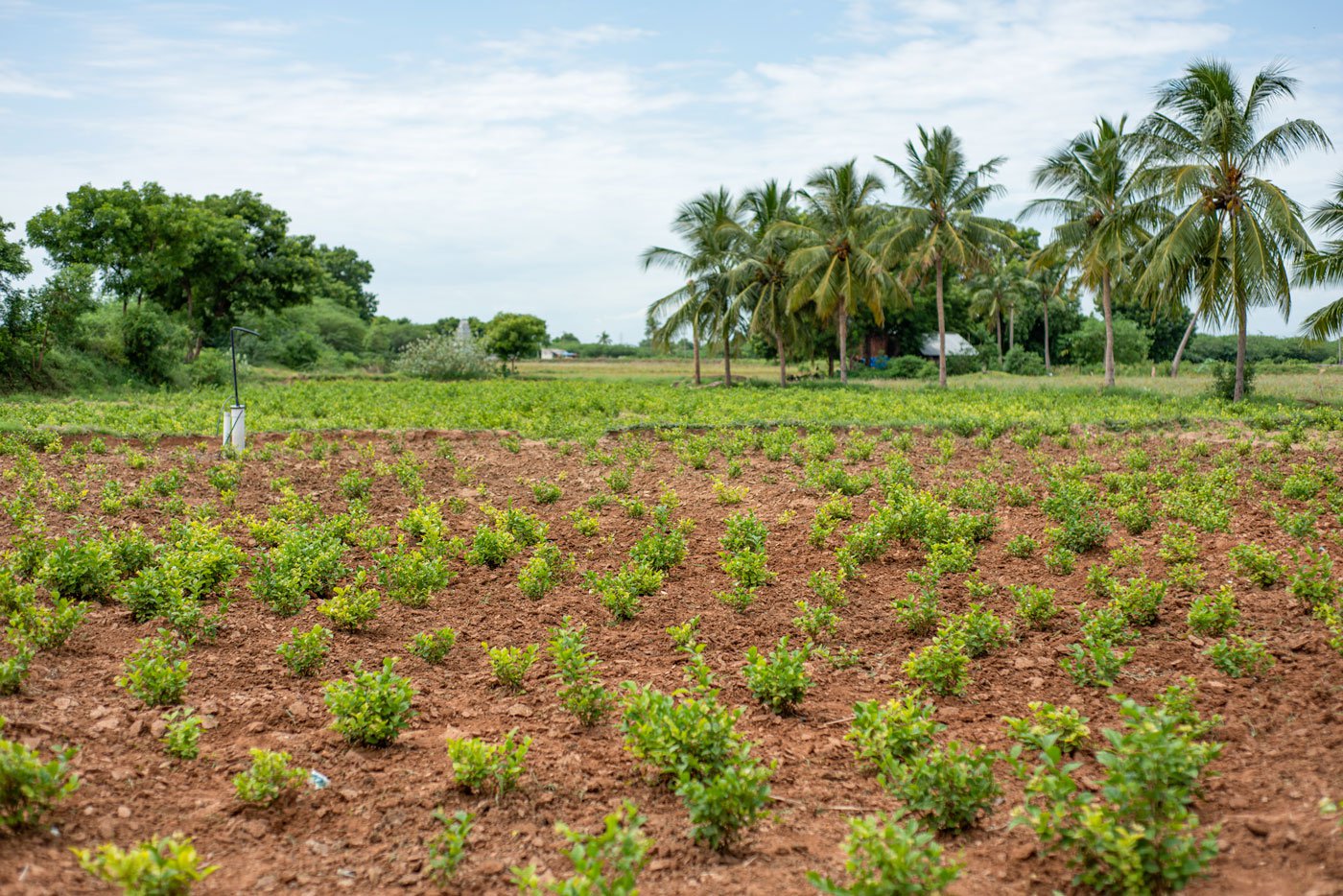
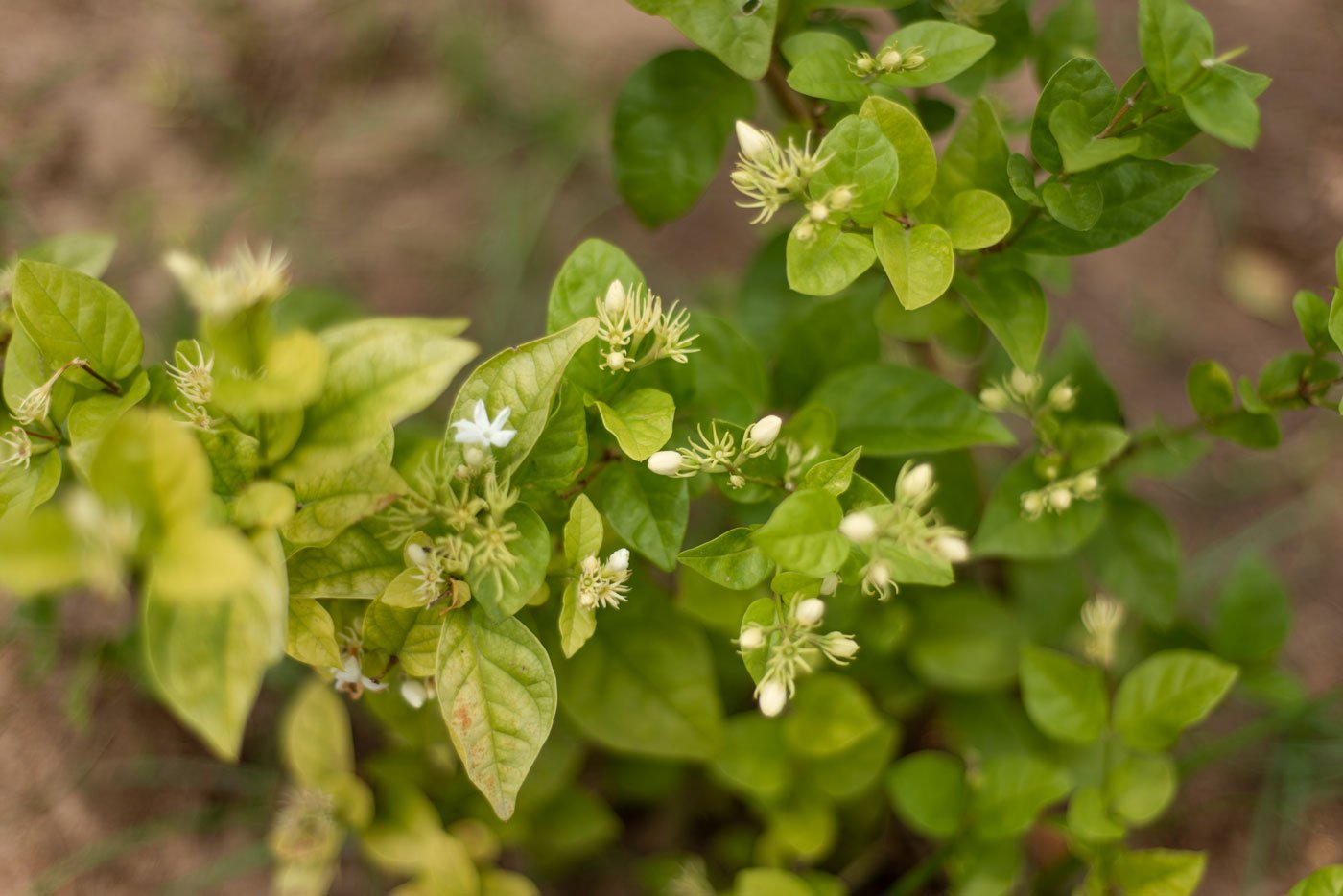
A field of new jasmine saplings and jasmine buds (right) at Ganapthy's fields
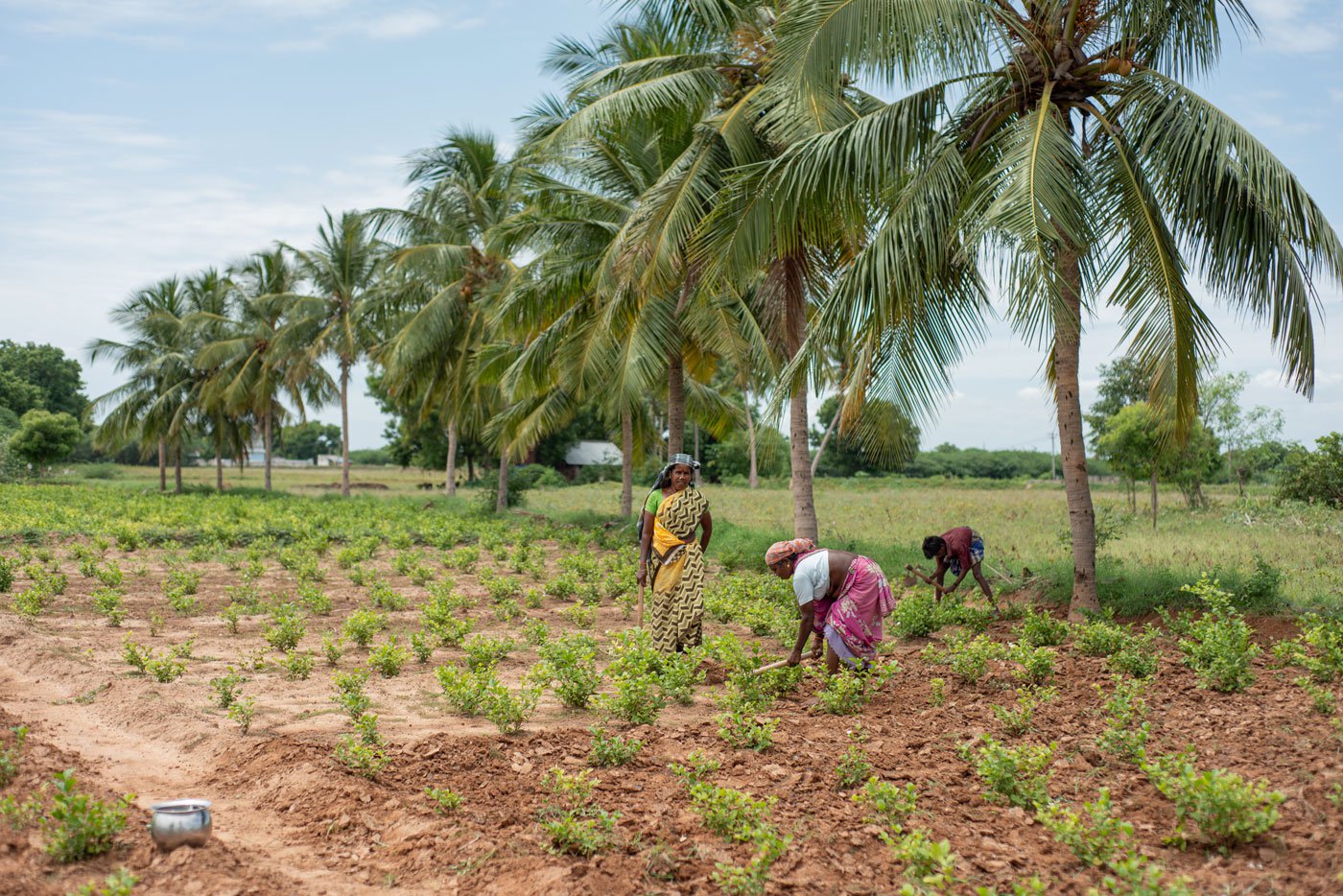
Pichiyamma working along with farm labourers to clean up the jasmine fields
On our second visit in August 2022, Ganapathy has a new batch of jasmine saplings in an acre: 9,000 seven-month-old plants. Each one – he holds out a finger and touches his elbow, to indicate the length – costs four rupees at nurseries in Thangachimadam, near Rameswaram, Ramanathapuram district. And he picks them out personally, to ensure a strong plant, one with promise. If the soil is good – rich, loamy, red – “you can even space them four feet apart. The plant will grow large,” Ganapathy tells me, making a circle with his hands, as wide as they would it go. “But here, you have soil that is better suited for chamber bricks.” That is, clayey soil.
Ganapathy spends 50,000 rupees to prepare an acre of earth for malli cultivation. “Doing it properly costs money, you know.” In summer, his fields are radiant with flowers. He says it in Tamil: “ Palichinnu pookum .” He smiles as he describes the day he harvested 10 kilos of flowers – some plants yielding 100 grams, some even 200 grams – his eyes eager, his voice excited, and his smile hopeful of it happening again. Soon.
Ganapathy’s workday begins around daybreak. It used to start an hour or two earlier, but now “workers come late,” he says. He hires help to pluck the buds. And pays 50 rupees for an hour’s labour, or anywhere between 35 and 50 for a “ dabba, ” a measure, which he thinks will hold a kilo of flowers.
Flower prices have gone up in the 12 months since PARI’s last visit. The floor price is set by the ‘scent’ factories. These are processing units which typically buy large volumes when there is a glut of jasmine, paying anywhere between 120 and 220 rupees for a kilo. At around two hundred rupees per kilogram, Ganapathy says, he does not make a loss.
When there’s high demand – and low production – a kilo of jasmine buds fetches many times that. It shoots beyond 1,000 rupees a kilo during festival days. But then, plants don’t follow calendars. Nor do they observe ‘ muhurtha naal ’ and ‘ kari naal’ – auspicious and inauspicious days.
They simply obey nature. When there is a sharp spell of sunshine, and then a good shower, the earth blooms with flowers. “Everywhere you turn, there is jasmine. You can’t stop the plants flowering, can you?” Ganapathy asks me with a smile.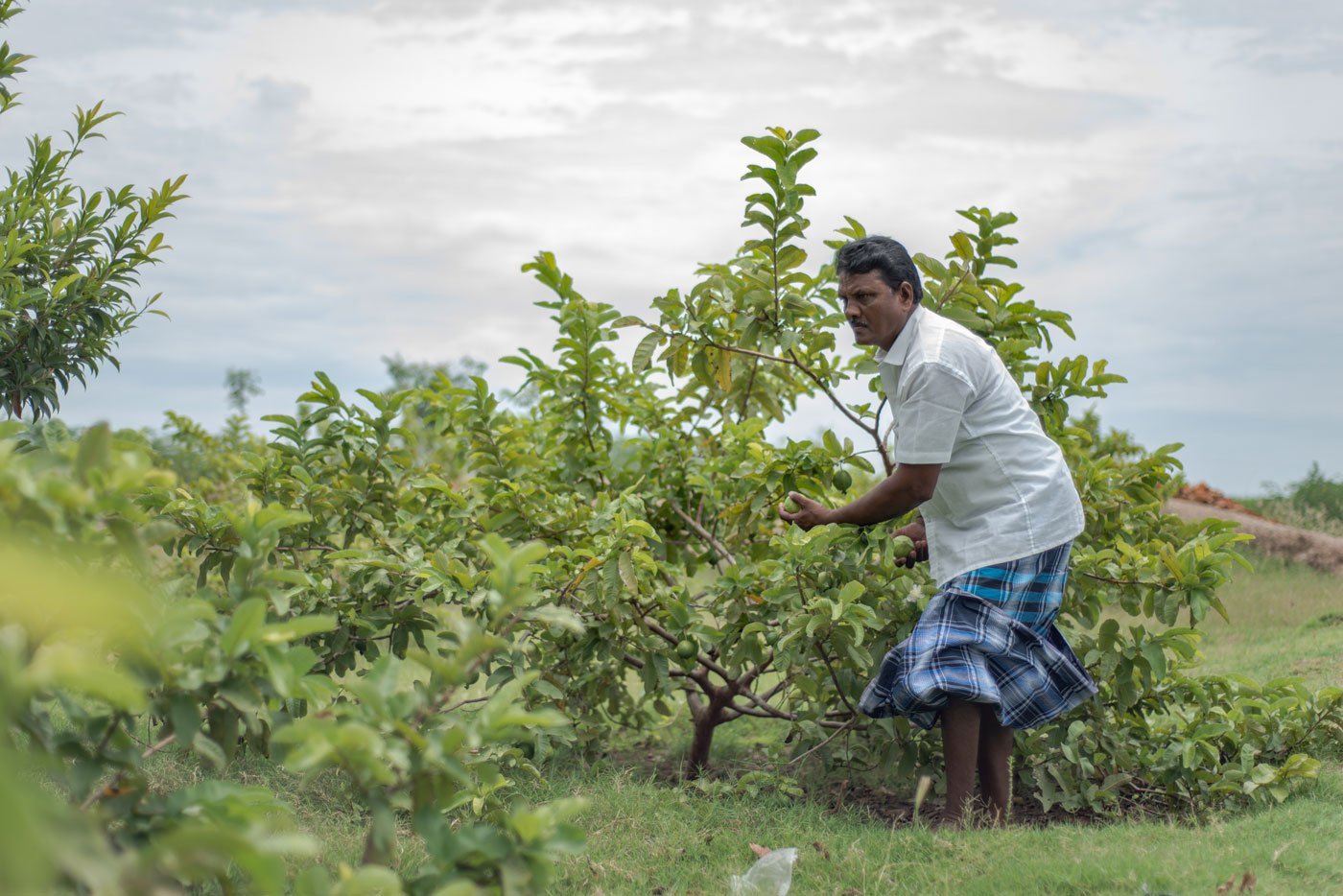
Ganapathy plucks fleshy guava fruits for us to eat
The rain flowers, as he calls them, flood the markets around Madurai. “Tonnes of jasmine arrive. Five tonnes, six tonnes, seven tonnes, why, one day we even got ten!” Most of it went to the scent factory, he explains.
For garlands and strings, flowers are bought and sold for upwards of 300 rupees a kilo. “But when flowering has peaked, we barely pluck a kilo, and the poor supply pushes up prices. If I got just 10 kilos when there is very high demand, I’d make 15,000 rupees in a day. Isn’t that such a huge income?” He laughs wistfully, with crinkled eyes and a bright smile, he adds, “Why, then I’ll pull up some chairs, arrange for a nice lunch, and I’d just sit here and give you interviews!”
Truth is, he can’t do that. Neither can his wife. There’s work to do. Much of it is coaxing the earth to produce a fragrant crop. Ganapathy grows guava plants in his remaining 1.5 acres. “This morning, I took 50 kilos of fruit to the market. They only buy it for 20 rupees a kilo. After the fuel expenses, I get about 800 rupees. When guava was not so commonplace in these parts, the buyers used to come and pluck it in my field and pay me 25 rupees a kilo. Those days are gone…”
Ganapathy invests nearly a lakh of rupees on saplings and preparing the field for his one acre of jasmine. This capital expense on the plants gives him flowers for at least 10 years. Every year, the malli season extends for eight months, generally between March and November. And, he says, there are good days, great days, but also stretches when there are no buds. On average, he estimates a gross profit of Rs. 30,000 a month from an acre in season.
That makes him sound far more prosperous than he is. Like most farmers he does not factor in unpaid family labour – his wife’s and his own – into the cultivation costs. What would those labour costs be if he accounted for them? He pegs it at “500 rupees worth that I put in daily, and 300 for my wife." If he factored that in, his Rs. 30,000 profit would shrink to around Rs. 6,000 rupees net.
Even for this, "you need to get lucky,” he points out. As we soon learn inside his motor shed, it is luck – plus some chemicals.*****
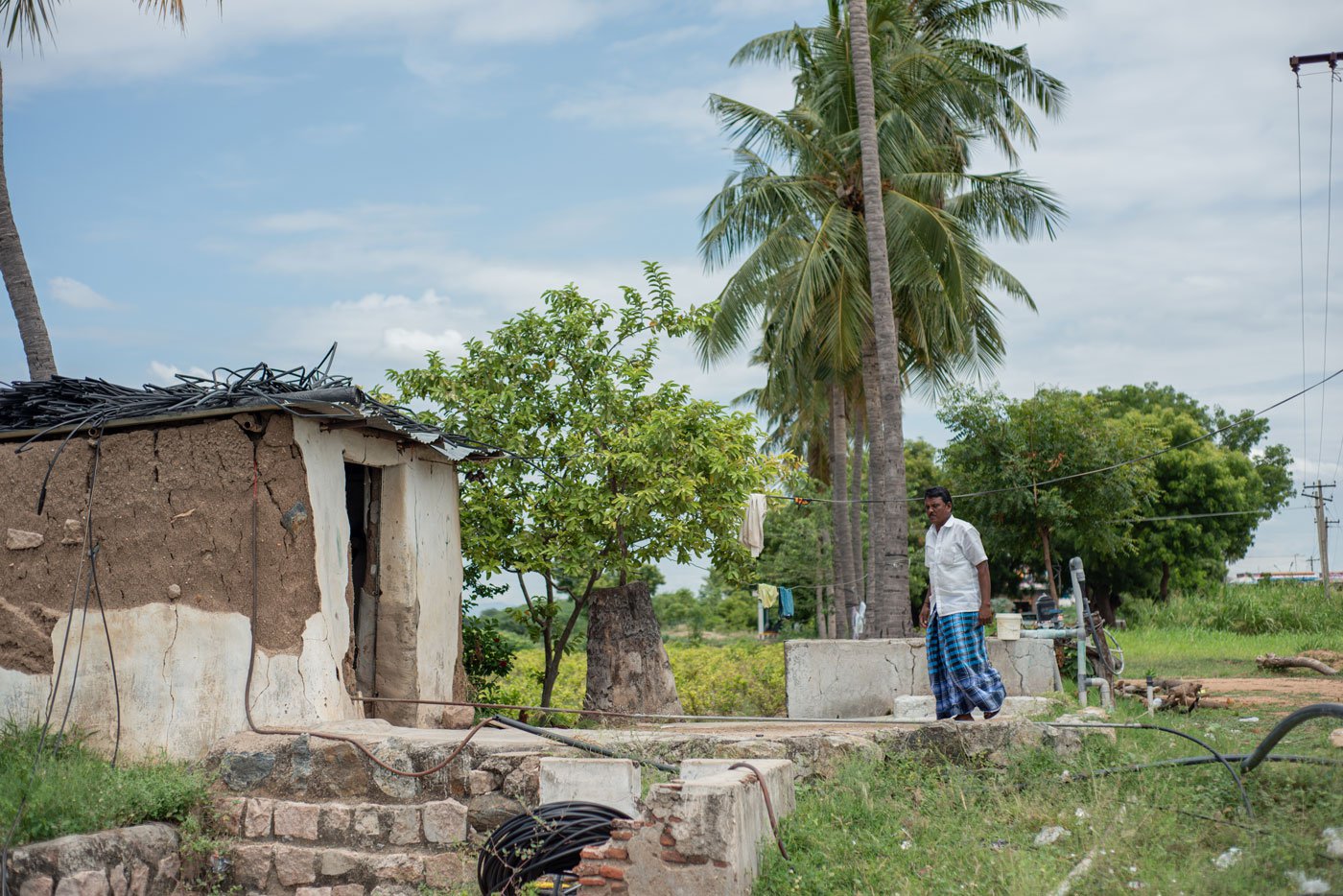
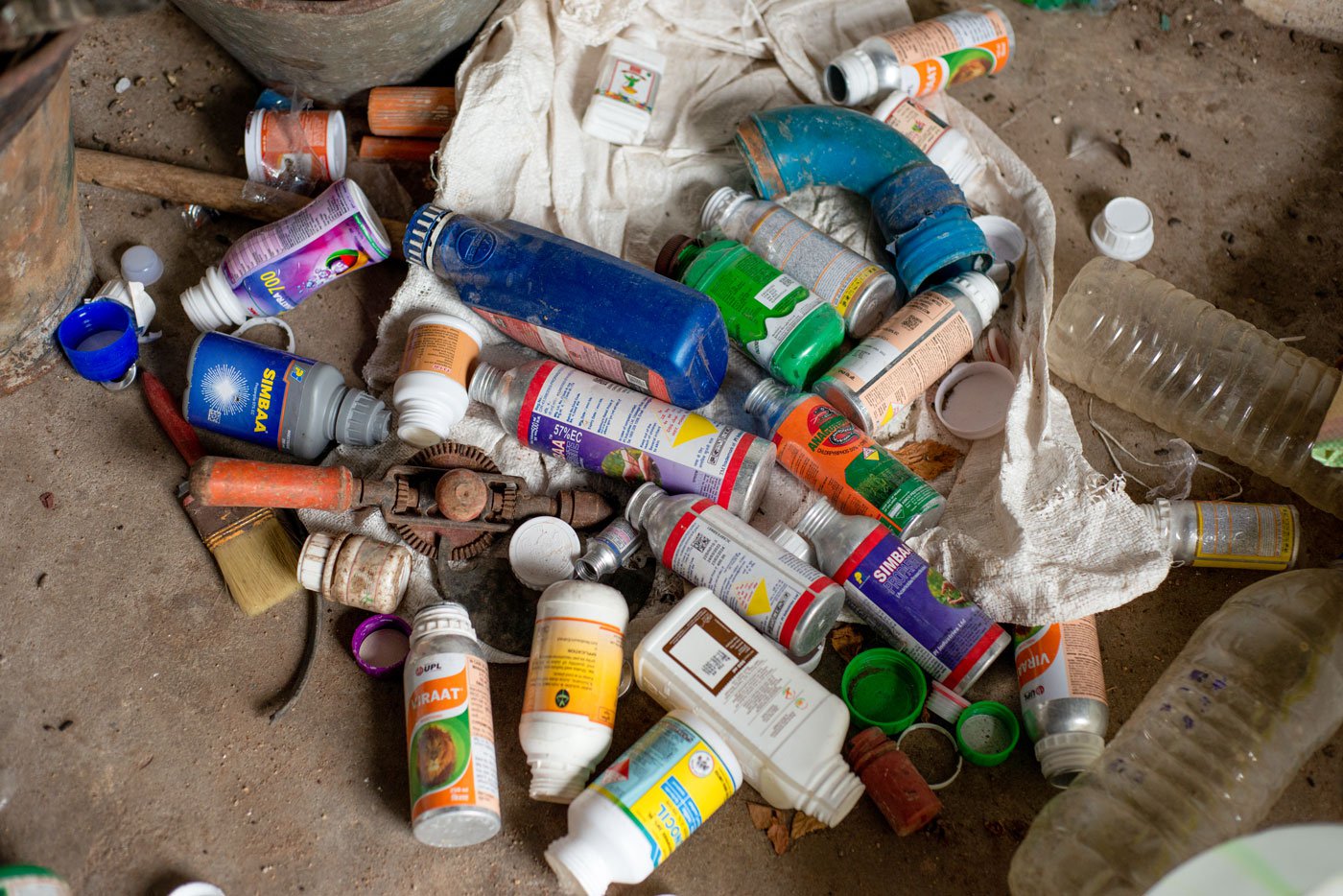
The motor shed in Ganapathy's farm. The floor is littered (right) with used bottles and cans of pesticide
The motor shed is a small room where Ganapathy’s dogs sleep in the afternoon. There is also a group of hens in the corner – and in fact the first thing we see is an egg – Ganapathy chuckles as he picks it up and holds it carefully in his palm. The floor is littered with many small cans and bottles of pesticide. It looks almost like a Showroom of Used Chemicals. They’re all necessary, Ganapathy patiently explains, to make his plants flower. “ Palichu ,” white jasmine buds, strong, heavy, with a good stem.
“What does this one say in English?” Ganapathy asks me, holding up some cans. I read out the names one by one. “This kills red lice, that one is for worms. And here, this destroys all these pests. So many pests attack jasmine plants,” he grumbles.
Ganapathy’s son is his advisor. “He works in a “ marundhu kadai ,” a shop that sells pesticides,” he explains, as we walk out into the scorching heat of a sun as white as his jasmine flowers. A puppy dog rolls in a patch of wet earth, its white fur gently reddening. A brown dog wanders near the shed. “What are they called,” I ask him. “I yell ‘ karuppu ’, they come running,” he grins. Karuppu is Tamil for black. The dogs aren’t, I point out.
“Well, they come anyway,” Ganapathy laughs and walks into another large shed. There are heaps of coconuts, over-ripe guavas in a bucket. “My cow will eat it. She is in that field now, grazing,” along with a few country chickens pecking, clucking, running.
Next, he shows me the fertilisers – store bought ‘soil conditioners’ in a big, white pail, for 800 rupees – plus sulphur granules and some organic manure. “I want a good yield in karthigai maasam [November 15 to December 15]. The rate will be very good then, given that it is the wedding season.” And leaning on a granite pillar in his outdoor shed, he smiles and tells me the secret to good farming: “You have to respect the plant. If you do, it will respect you.”

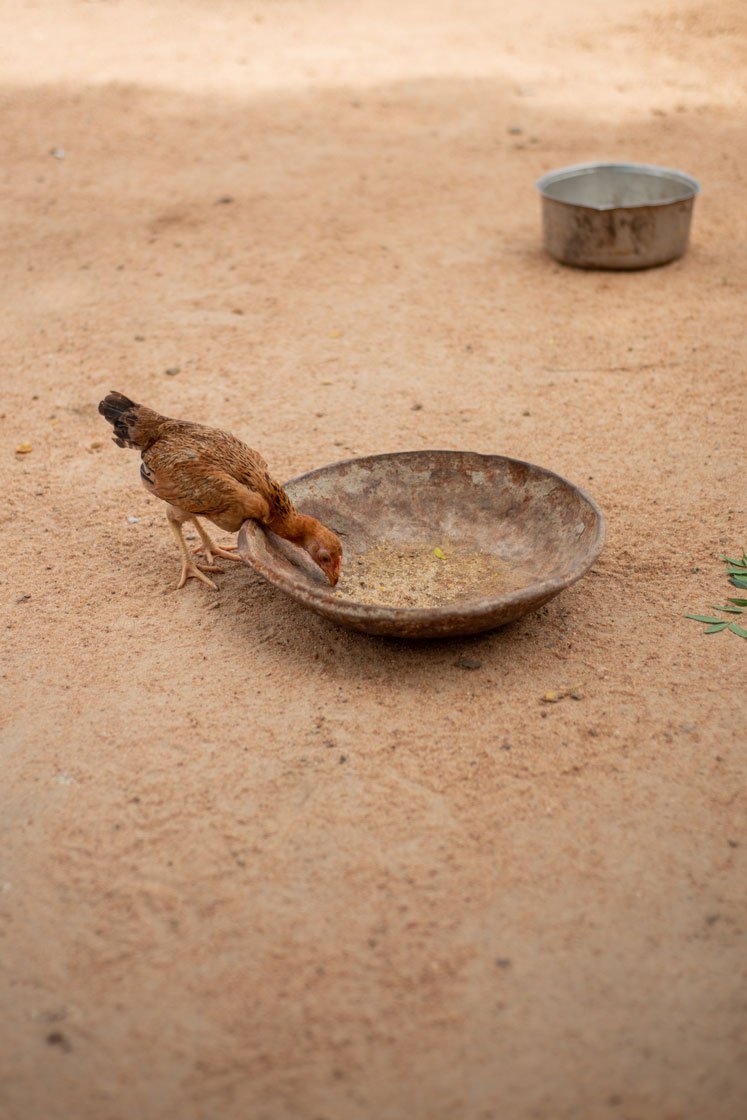
Ganapathy in the company of his two dogs – both called Karuppu (black) – in his courtyard. Right: A chicken pecking at its food
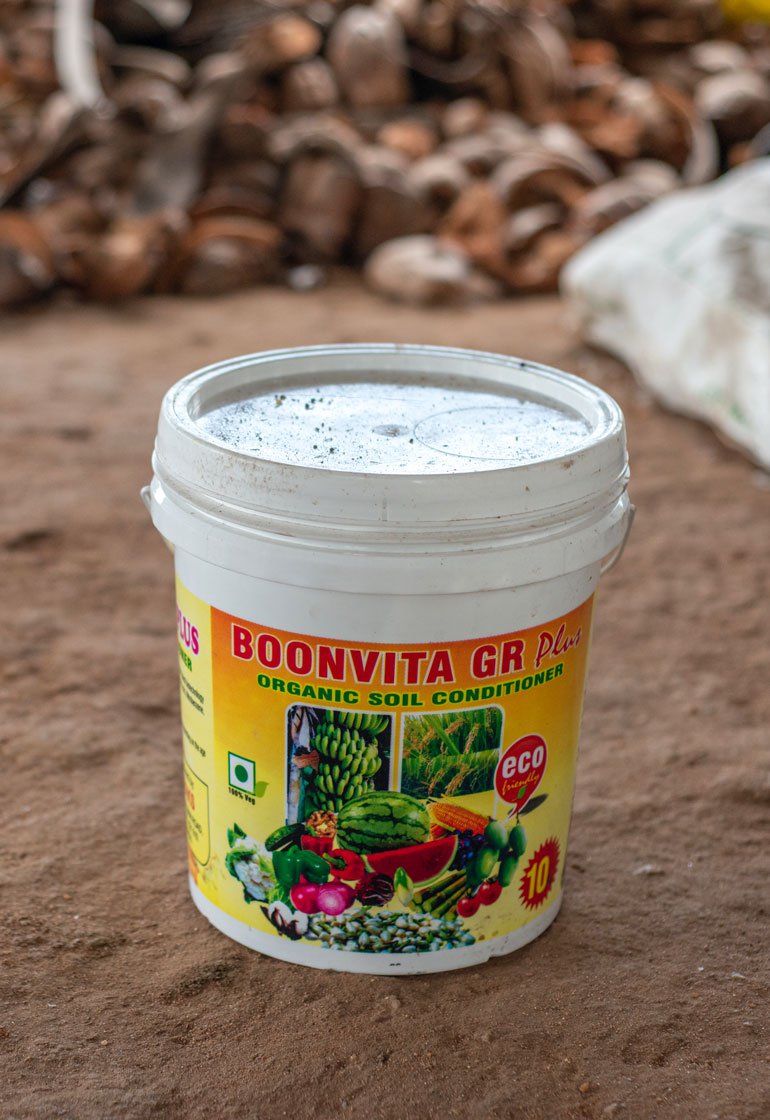
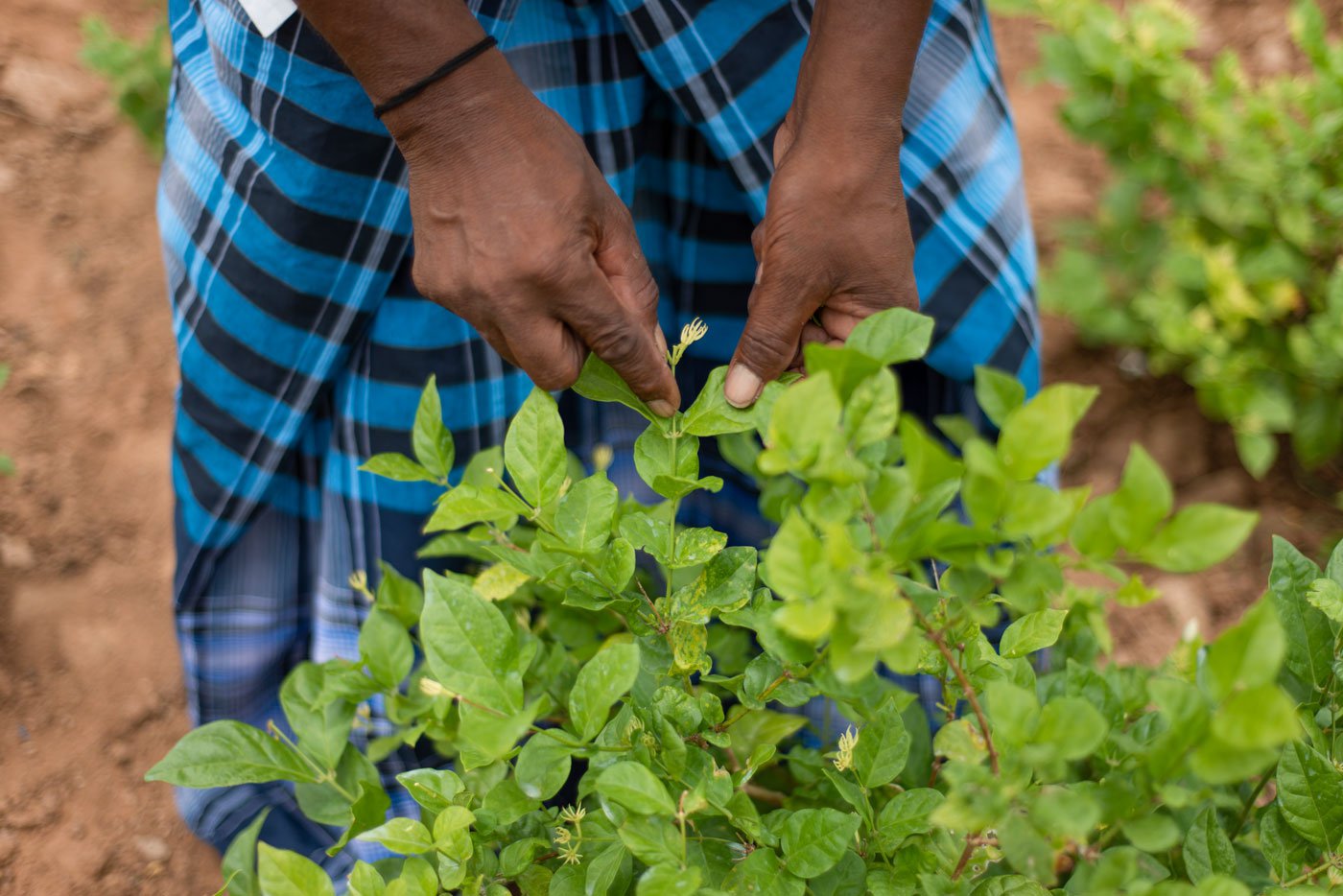
Left: A can of fertiliser. Right: Ganapathy shows where pests attack the jasmine plant
Ganapathy is a great raconteur. For him, the fields are like theatres where every day there is some drama. “Yesterday, around 9:45 in the night, four pigs came from that side. Karuppu was here, he saw the pigs, they were attracted to the smell of ripe guavas, he chased three of them, one ran away that side,” he waves his hands towards the main road, the temple across, and the open fields all around. “What can you do? Long ago, there were predators – foxes – now there are none.”
If pigs are a problem, so are pests. Walking around the jasmine fields, Ganapathy describes how quickly and viciously pests attack new blossoms. Next, he explains the planting dimensions by drawing squares and circles in the air and plucks a few pearly flowers for me to admire. And smell. “Madurai malli has the best fragrance,” he asserts.
I agree. It is a heady smell, and it feels like an honour: to walk around his dug well, over the rust-coloured earth, our feet crunch-crunching the gravel, Ganapathy speaking knowledgeably about farming, and respectfully of his wife Pichaiyamma. “We are not big landlords, we are a chinna samsaari [small holding], and we can’t just sit around and order people. My wife works alongside our labourers, that’s how we survive, you know.”*****
Jasmine has survived in this land for at least 2,000 years and has an extraordinary history. And the flower is woven into the Tamil past – lending it form and fragrance – as elegantly as it is strung together with thread to form a garland. There are more than 100 mentions of mullai – as jasmine flowers were then called - in Sangam literature, besides several other varieties of the flower, says Vaidehi Herbert, a Hawaii-based Sangam Tamil Scholar and translator. Vaidehi has translated all the 18 Sangam-era books, written between 300 B.C. to 250 A.D, into English and hosts the work online free of charge.
It is the word mullai , she explains, that was the root word for malligai , which we now know as malli . In Sangam poetry, mullai is the name of one of the five interior landscapes – 'akam thinnais' – and denotes forests and adjoining lands. The other four – also named after flowers or trees - are: kurinji (mountain), marutham (fields), neythal (seashore) and pālai (dry wilderness).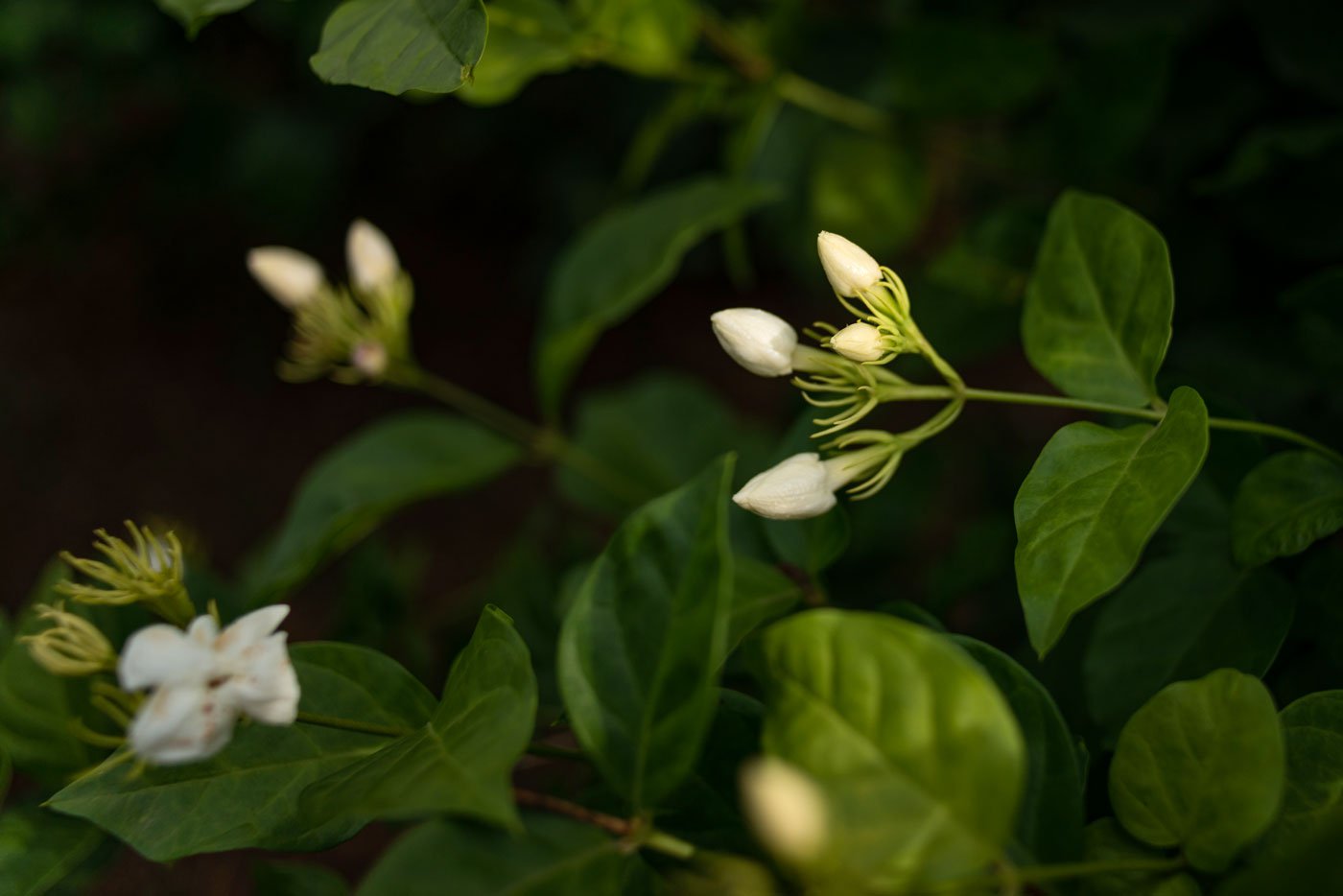
Jasmine buds and flowers in Pandi's field in Nadumudalaikulam hamlet in Usilampatti taluka of Madurai district
In her blog , (Vaidehi notes that Sangam writers have "used akam===== thinais to achieve poetic effect." The metaphors and similes, she explains, "are based on elements in the particular landscape. Flora, fauna and the very landscape itself are used to express the physical traits and emotions of the characters in the poems." In those verses set in the mullai landscape, the theme is " waiting patiently." That is, the heroine waits for her man to return from a journey.
In this Ainkurunooru poem, going back over 2,000 years, it is the man who longs for his woman’s fine features:
As a peacock dances like you,
As jasmines bloom fragrant
Like the scent of your forehead,
As a doe gazes timidly like you,
I rush home thinking of you,
My girl, swifter than a monsoon cloud.
Chenthil Nathan, translator of Sangam-era poems, who runs OldTamilPoetry.com, finds me another verse, this one etched in popular memory about Chief Pari, one of the seven great patrons mentioned in Sangam poetry. It is a long poem, Chenthil says, but these four lines are beautiful. And relevant.
...Pari, of widespread fame,
Who gave away his majestic chariot with bells
To a blooming jasmine creeper floundering without support
Though it would never be able to sing his praise…
Puranaanooru 200
, Lines 9-12
The scientific term for the malli variety that is widely cultivated in Tamil Nadu today is Jasminum sambac . The state leads the country in cultivation of loose flowers (as opposed to cut flowers). And is the clear leader in jasmine production , contributing 180,000 out of a total 240,000 tonnes grown in India.
Madurai malli – with a GI ( geographical indication ) to its name – has several special characteristics. Among them: ‘deep fragrance, thick petals, lengthiest petiole, delayed opening of buds, delayed petal discolouration and keeping quality (long shelf life).’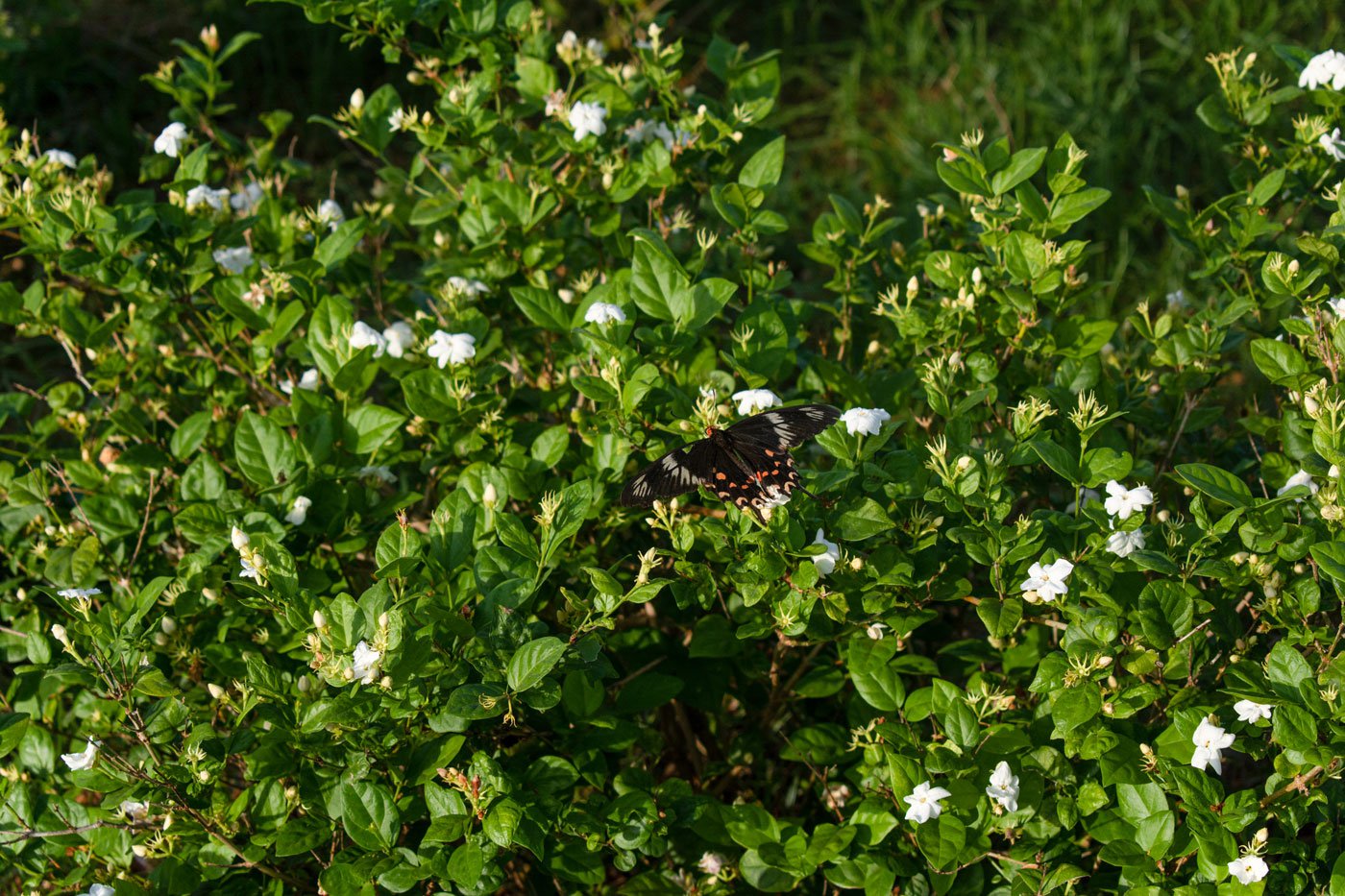
Butterfly resting and sipping on a jasmine flower
Other varieties of jasmine too, have interesting names. Besides Madurai Malli, they are called Gundu Malli, Namma Ooru Malli, Ambu Malli, Ramabanam, Madhanabanam, Iruvatchi, Iruvatchippoo, Kasthuri Malli, Oosi Malli and Single Mogra.
Madurai malli , however, is not restricted to just Madurai, but to the region, growing in a clutch of districts, including Virudhunagar, Theni, Dindigul and Sivagangai. While all flowers put together are cultivated in 2.8 per cent of the agricultural fields in Tamil Nadu, jasmine varieties take up 40 per cent of this land. Every sixth jasmine field – that is, 1,666 of a total 13, 719 hectares in the state – is in the Madurai region.
While these numbers look lovely on paper but in reality, price fluctuations lay the farmer low. It is, in a word, crazy. They range from a base price of 120 rupees a kilo at the Nilakkottai market for ‘scent’, all the way up to 3,000 and 4,000 rupees in Mattuthavani flower market (in September 2022 and December 2021), astronomical rates that seem both absurd and unsustainable.*****
Farming flowers is a lottery, it’s all about the timing. “If your plants flower during the festive season, then you make a profit. Otherwise, your children will think twice before they take up this occupation, won’t they? They only see the parents suffer, no?” Ganapathy does not wait for a response. He continues: “A small farmer cannot compete with a big one. If someone needs labourers to pluck 50 kilos on a vast tract of land, they will pay the workers 10 rupees extra and take them away in a vehicle and give them tiffin. Can we do that?”
Like other small farmers, he takes “ adaikalam ”, refuge, with big traders. “During peak flowering, I go to the market so many times – morning, afternoon, evening – with sacks of flowers. I need the traders to help me sell my produce,” Ganapathy points out. For every rupee of jasmine he sells, the trader claims 10 paise as commission.
Five years ago, Ganapathy borrowed a few lakhs from a big Madurai flower trader, Pookadai Ramachandran, also the President of the Madurai Flower Market Association. And he settled the money by selling him flowers. In such a transaction, the commission is higher and jumps from 10 to 12.5 per cent.
Small farmers also take short-term loans to buy pesticides among other inputs. And the conflict is constant – between plant and pest. Ironically, even when the crop is hardy, as in the case of ragi, a very large creature – such as an elephant – could raid the fields. Farmers struggle to come up with ingenious solutions to save their ragi fields. They are not always successful, and many have switched to flowers. In the flower-growing regions of Madurai, cultivators fight tiny creatures – bud worms, blossom midges, leaf webbers and mites – which leave behind discoloured flowers, damaged plants, and devastated farmers.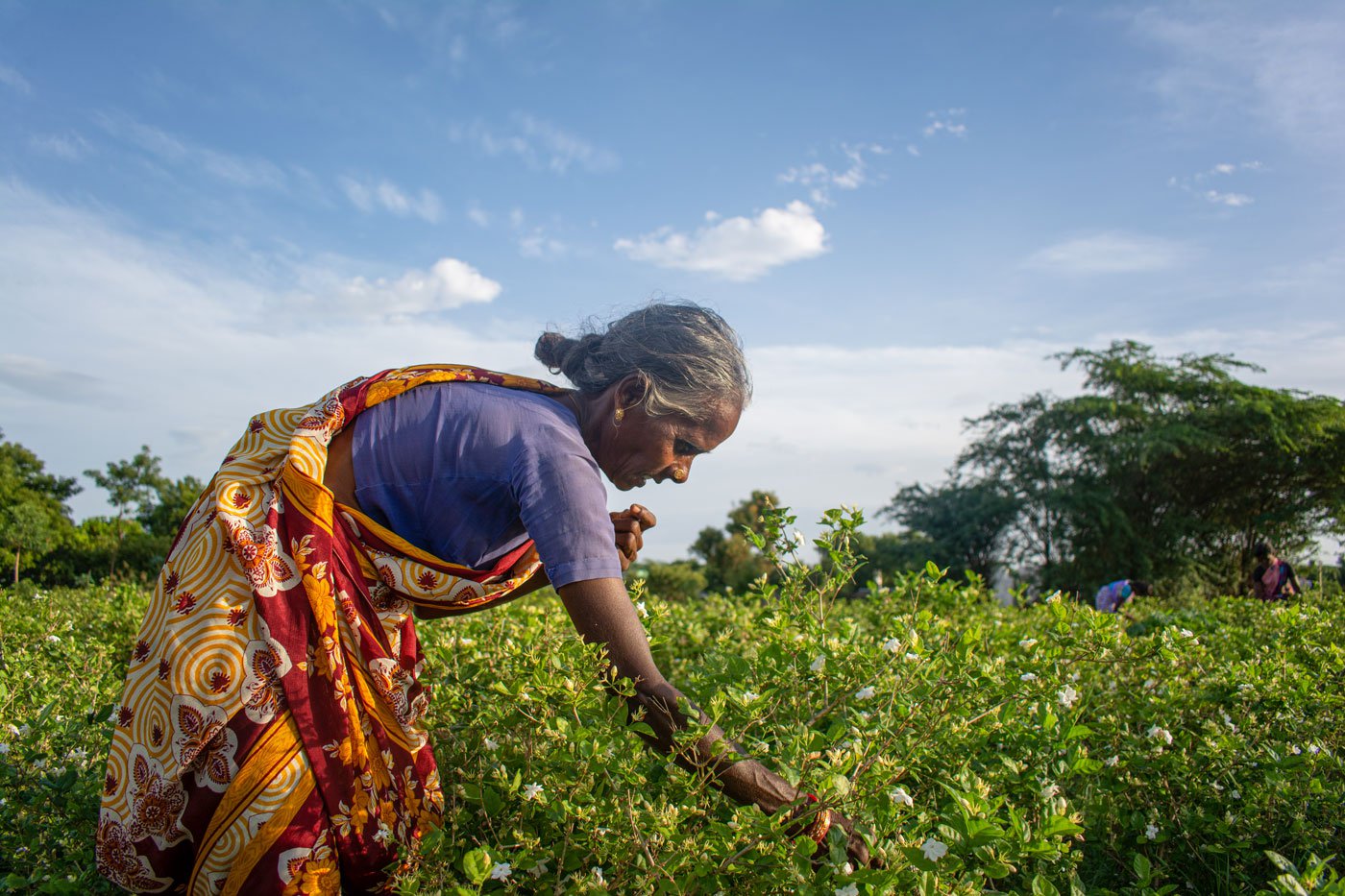
Chinnama working on her jasmine field in Thirumal village of Madurai district, that is riddled with many pests
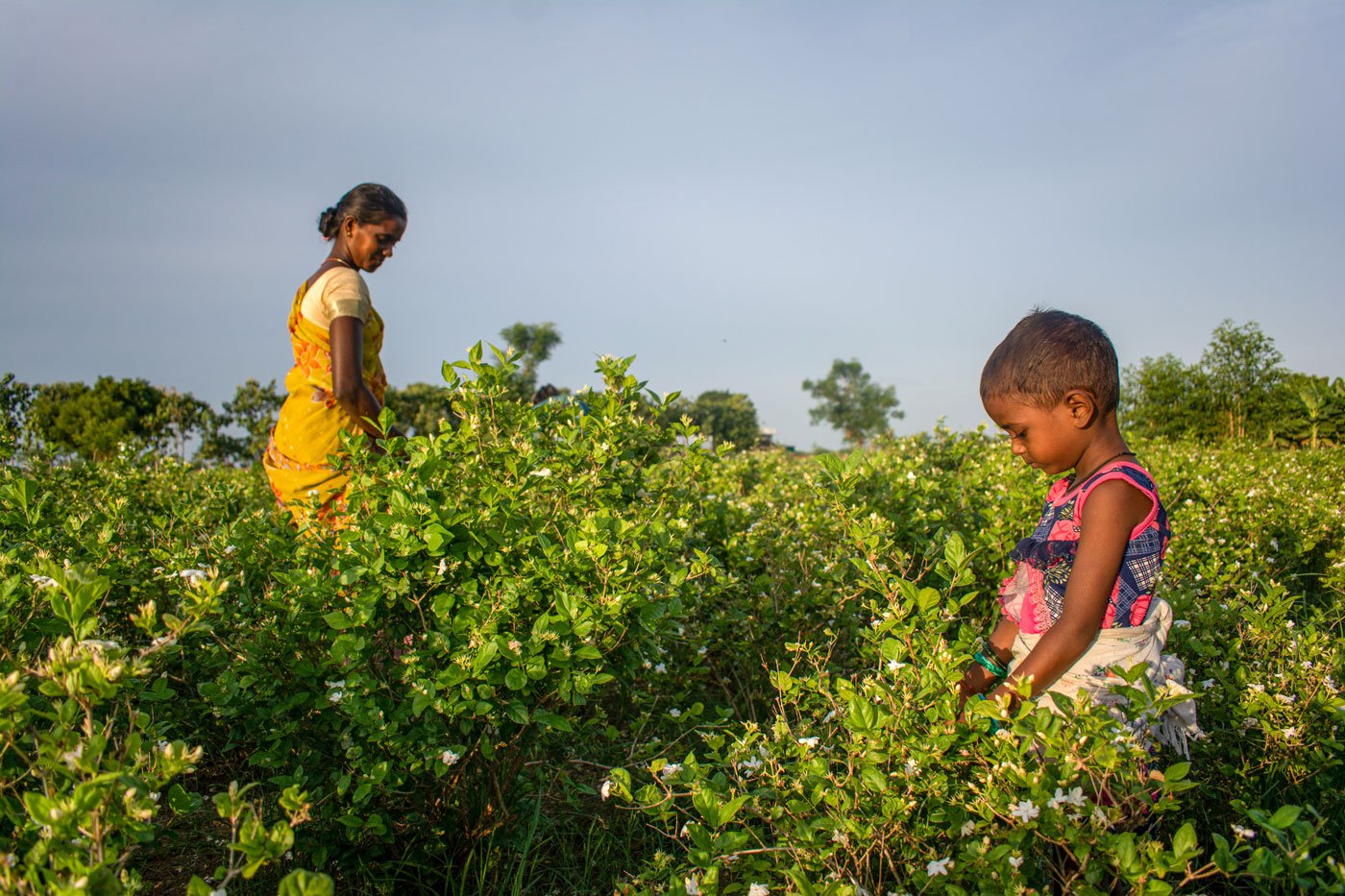
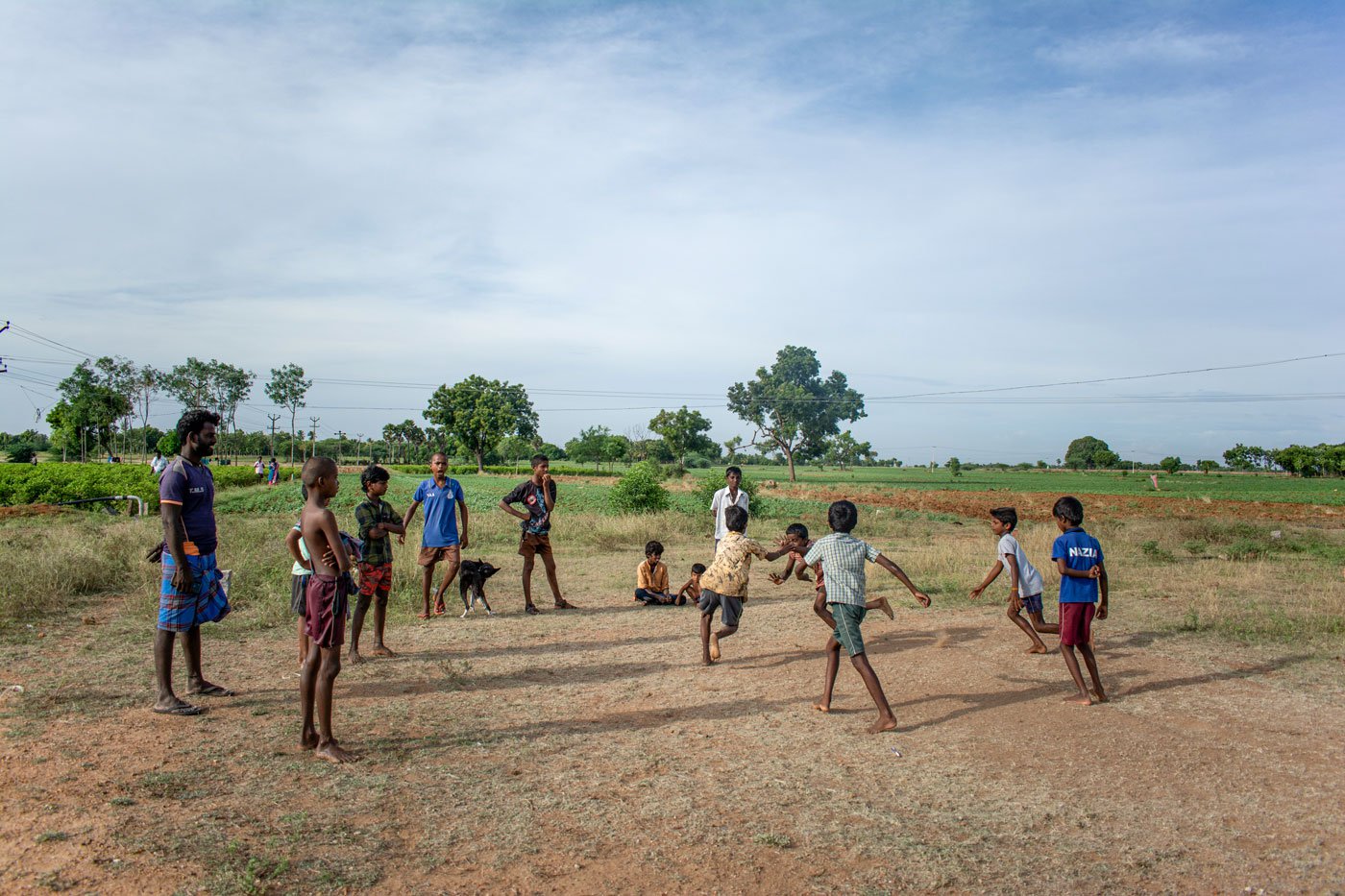
Both young and old pitch in with the plucking. Right: A spot of kabaddi next to the jasmine fields here in Thirumal village
In Thirumal village, a short ride from Ganapathy’s house, we see a whole field ruined. And along with it, dreams. The malli thottam (jasmine farm) belongs to R. Chinnama, 50 and her husband Ramar. Their two-year-old plants are white with jasmine. But they are all, she says, “second quality flowers, which will fetch a far lower price.” They are diseased, she sighs, clicking her tongue, shaking her head. “The flowers won’t open; they won’t grow big.”
The labour involved, however, is relentless. Old women, young children, college-going girls – all of them pluck. Chinnama speaks to us as she tenderly moves the branches, looking for buds, snapping them, dropping them into her saree draped in the kandangi style. Her husband Ramar tried many pesticides on the fields. “He used many ‘weighty medicines,’ they were not ordinary ones. They cost us 450 rupees a litre. But nothing worked! It got to a point where the shop owner told him not to waste any more money.” Ramar then told Chinnama, “Just pull the plants out. We’ve lost 1.5 lakhs.”
That’s why her husband was not in the field, Chinnama said. “ Vayitherichal ,” she says, the Tamil word literally meaning a burning stomach, indicating bitterness and envy. “When others get 600 rupees for a kilo of jasmine, we’ll get 100.” But her anger or irritation is not directed at the plants. She holds the branches delicately, bending them just enough to reach the buds beneath. “If we had a good crop, it would take us several minutes to pluck a big plant. But now…” and she moves to the next one quickly.
The yield depends on many factors, says Ganapathy, throwing his towel over his shoulder, and lending a hand with Chinnama’s plants. “It varies according to the soil, the growth, the skill of the farmer. You raise it like a child,” he says, once again. “A baby cannot ask you for this or that, isn’t it? You must anticipate and intuitively respond. Unlike an infant, a plant cannot cry. But if you have the experience, you will know… if it is sick, diseased, or dying.”
Many of these are ‘cured’ with a cocktail of chemicals. I ask him about growing jasmine organically. His response captures the dilemma of the small farmer. “You can, but there are more risks involved. I have attended organic-farming training,” Ganapathy says. “But who will pay a better rate for it?” he asks sharply.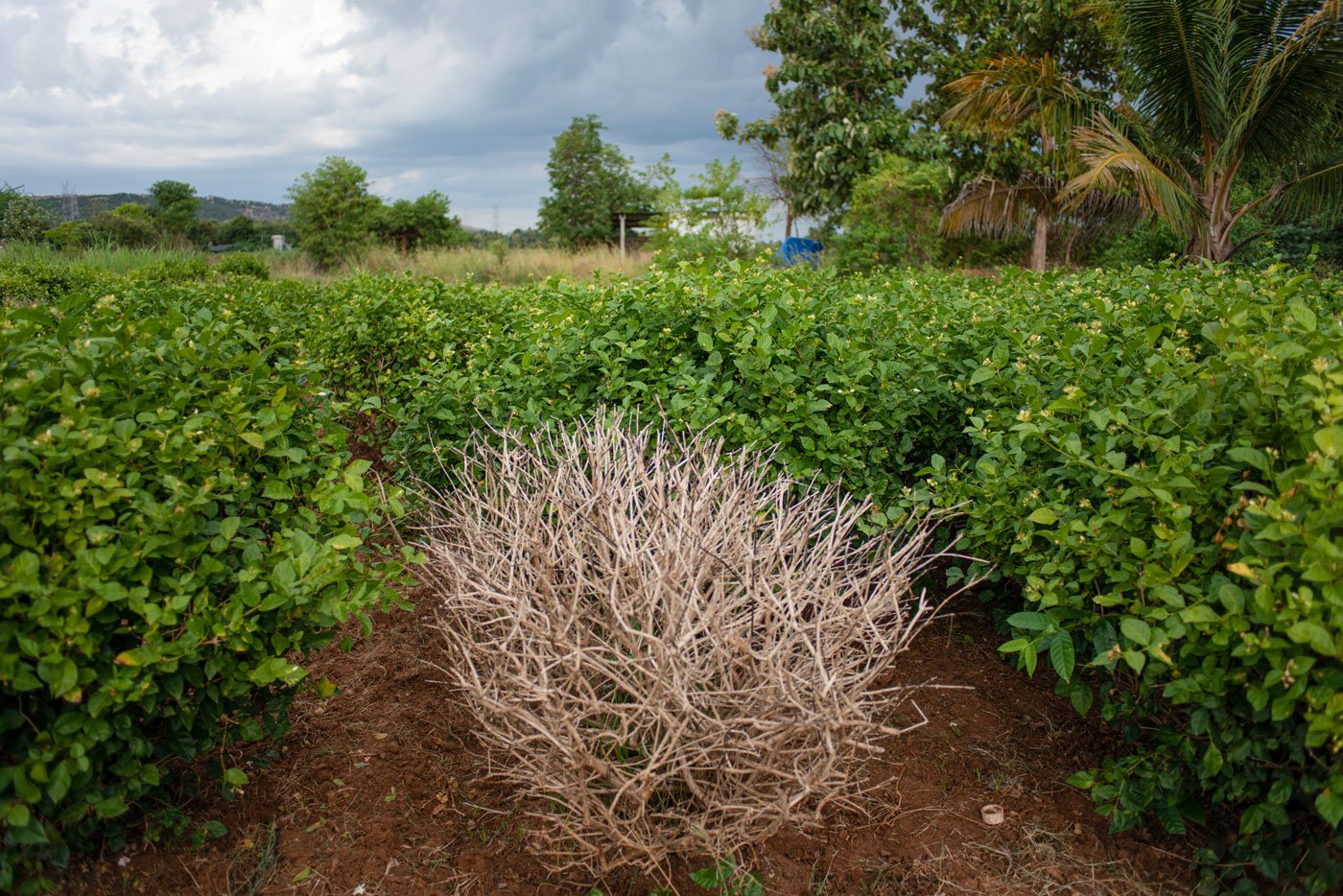
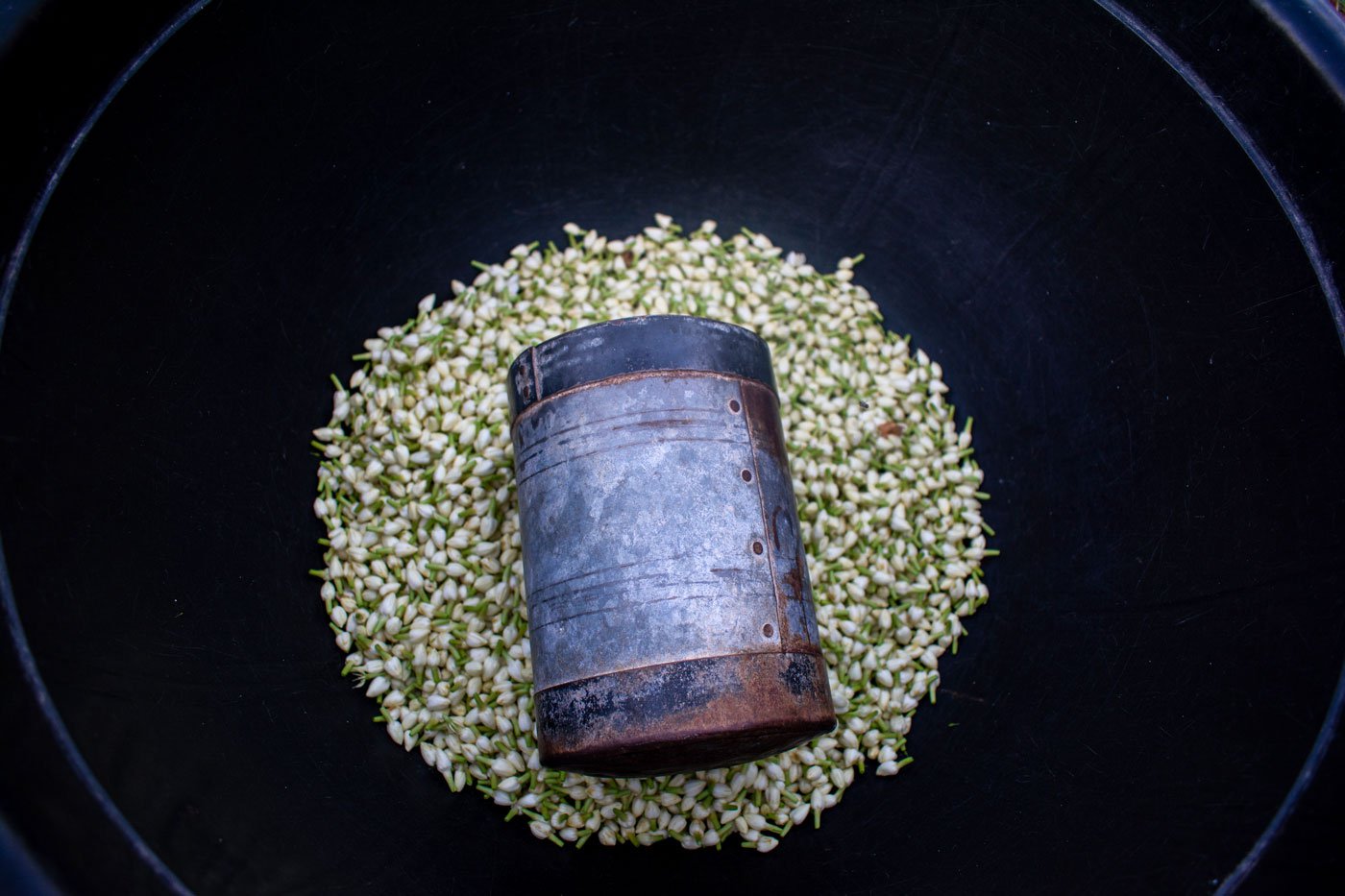
Left: A dead plant surrounded by healthy jasmine plants. Right: Jasmine buds in a pail with a padi (measure) that is used to calculate the quantity plucked by each worker, and from that, the wages due
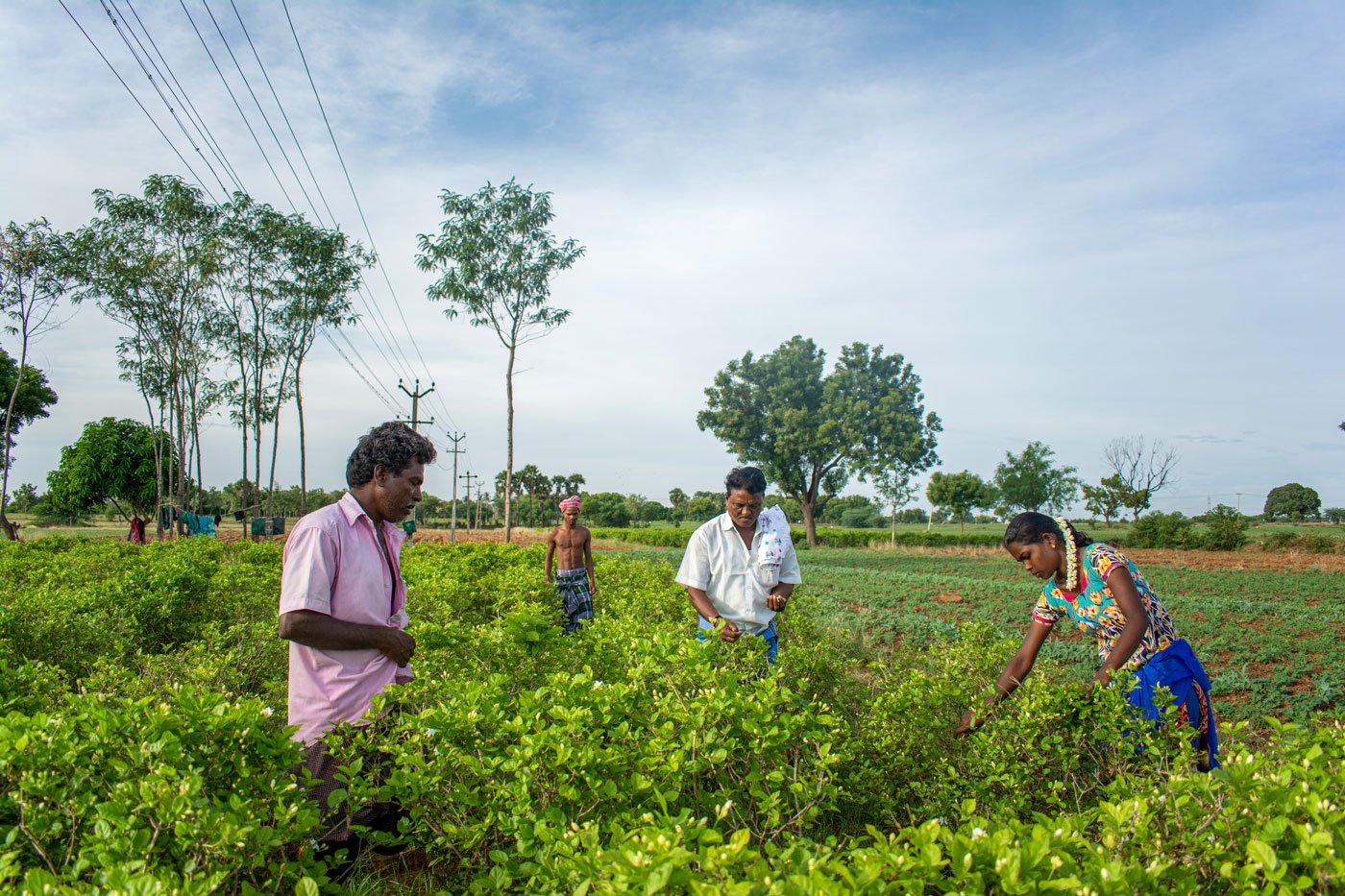
A group of jasmine pluckers , both owners and labourers, are chatting, listening to music and racing against time to get the flowers to the market before they bloom
“Chemical fertiliser will give a better yield. And it is easier. Organic is fussy and messy – you soak all the ingredients in a tub and spray it carefully and then when you take it to the market, there is no price difference! Which is sad because organic jasmine is bigger and brighter. Unless it fetches a much better rate – say, double the price – it isn’t worth my time and effort. “
For his household, he grows organic vegetables. “Just for us and my married daughter who lives in the next village. I too want to move away from chemicals. They say there are a lot of side effects. With so much exposure to strong pesticides, of course your health is affected. But what is the alternative?”*****
For Pichaiyamma, Ganapathy’s wife, there is no alternative either. She works all day. Every day. Her survival hack is a smile. It is wide, it hardly wavers. It is late August 2022 and PARI’s second visit to their house. Sitting on a cot in the courtyard, under the cool shade of the neem tree, she describes her workday.
“ Aada paaka, maada paaka, malligapu thottam paaka, poova parika, samaika, pullaigala annupivida… [Caring for the goats and cows and the jasmine fields; plucking malli ; cooking, sending the kids to school…].” It’s one breathless list.
The relentless work is all for the children, Pichaiyamma, 45, says. “My son and daughter are both well-educated and degree holders.” She’s never been to school herself and has worked from when she was a kid on her parents’ farm, and now on hers. She wears some jewellery on her ears and nose; on her neck is a turmeric thread with the thali ( mangalsutra).
The day we meet her, she is weeding the jasmine fields. It is punishing work – with her back bent the whole time, taking small, mincing steps, labouring under a harsh sun. But right now, she’s only concerned about us, her guests. “Please eat something,” she says. Ganapathy fetches us fleshy, fragrant guavas and tender coconut water. And while we snack and sip, he explains that the educated and the young have moved from the village to the city. Land here sells for not less than Rs. 10 lakh an acre. If it is close enough to the main road, it sells at four times that rate. “It is then sold as ‘plots’ for houses.”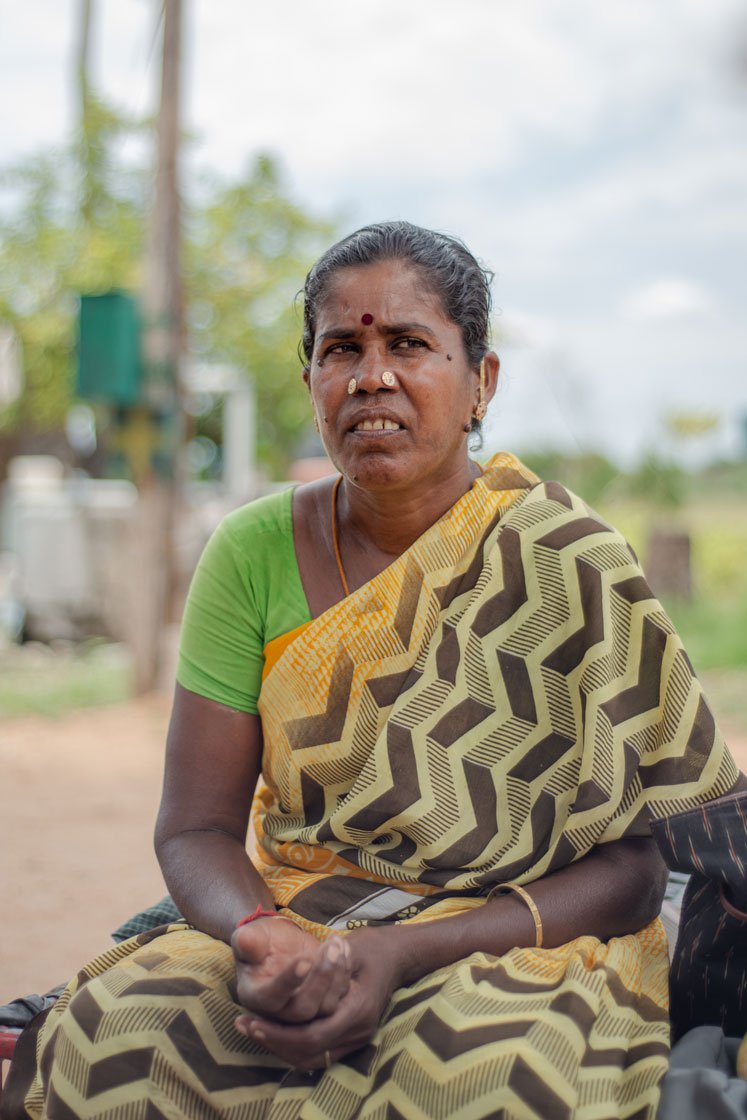
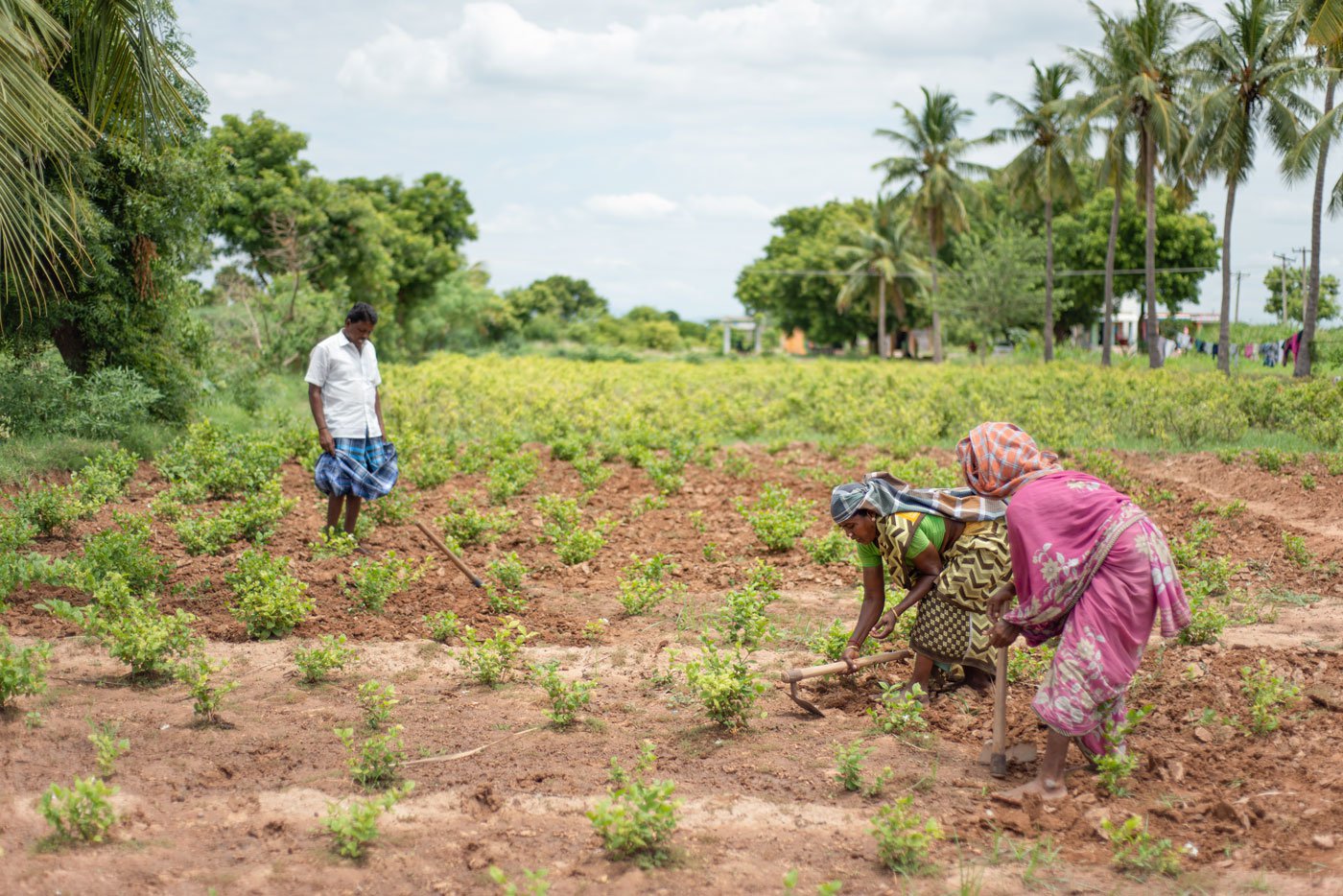
Pichaiyamma telling me about her day where she a nd a hired labourer (right) from the village remove weeds and work on their jasmine fields
Even among those who own land, there is some guarantee of profit only if the household puts in their own ‘free’ labour. Ganapathy acknowledges that the share is greater for women. What would your wage be, if you did the same work for someone else, I ask Pichaiyamma. “300 rupees,” she replies. And that does not include her household labour, nor what she puts in to maintain their livestock.
“Would it be right to say you save your family 15,000 rupees, at least?” I ask. She readily agrees, as does Ganapathy. I suggest, in jest, that she must be paid that amount. Everybody laughs, Pichiayamma the longest.
Then, with a gentle smile and piercing eyes, she asks me about my daughter, how much gold I will have to give her for her wedding. “Over here we give 50 sovereigns. Then, when there is a grandchild, we present a gold chain and silver anklets; when the ears are pierced, a goat for the feast; it goes on. It all comes from our earnings. Tell me, can I afford to take a salary?”*****
A salary, I learn that evening from a young jasmine farmer, is a good – and necessary – supplement for agriculture. It’s an important fall back, a steady income, even if it means double the workload. Six years ago, I heard the same logic in Nadumudalaikulam hamlet, Usilampatti taluk , in Madurai district, from paddy farmers Jeyabal and Podhumani. On this trip, in August 2022, Jeyabal introduces me to his childhood friend and jasmine farmer M. Pandi who has a postgraduate degree in Economics and a fulltime job with Tamil Nadu State Marketing Corporation Limited (TASMAC) which has exclusive rights to sell Indian-made foreign liquor (IMFL) in the state.
Pandi, 40, wasn’t always a farmer. He begins telling us his story enroute to his fields, a 10-minute ride from the village. We are surrounded by miles of green – hills, water bodies, and the sparkle of white jasmine buds.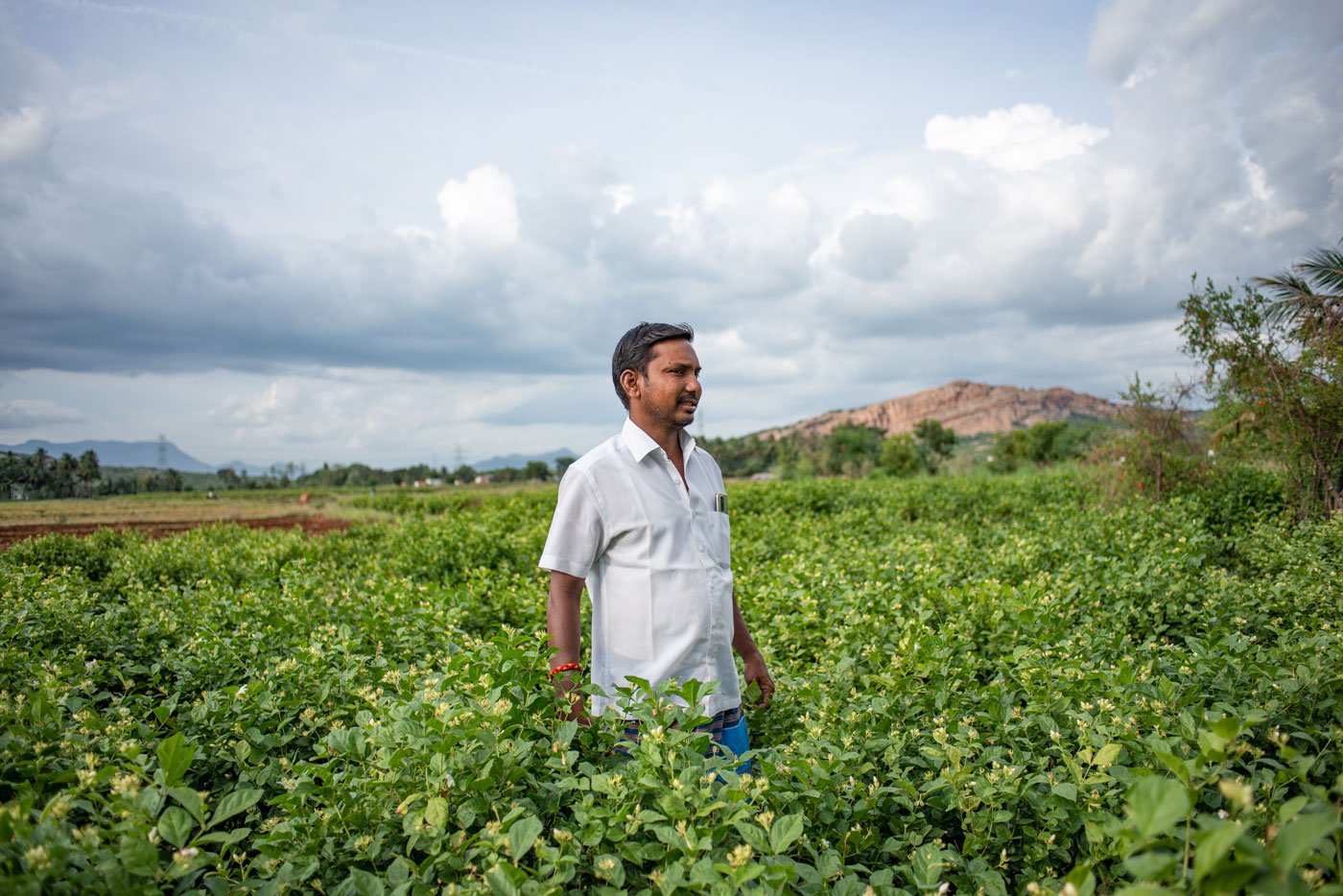
Pandi in his jasmine fields in the beautiful Nadumudalaikulam hamlet where many farmers also cultivate paddy
“I joined TASMAC 18 years ago, right after my education. I still work there and tend to my jasmine fields in the mornings.” In 2016, the then newly elected chief minister and head of AIADMK J. Jayalalitha, reduced the working hours of TASMAC from 12 to 10 hours. Whenever he refers to her, Pandi speaks of her as ‘ Manbumigu Puratchi Thalaivi Amma Avargal ’ (revered revolutionary leader, Amma), the title that is both deferential and formal. Her decision freed up his mornings as he now had to get to work only by 12 noon (instead of 10 a.m.). He has since devoted those two saved hours to his land.
Pandi speaks with clarity and conviction about both his occupations, while he sprays his jasmine fields with pesticide. “See, I’m an employee and I also employ 10 labourers to work on my field.” There is a quiet pride in his voice. But it is tempered with reality. “But then, you can only farm now if you own land. Pesticides sell for hundreds of rupees, even thousands. Because I get a salary, I can manage. Otherwise, farming is very, very hard.”
Jasmine farming is still harder, he points out. Plus, you have to plan your life around the plants. “You can’t go anywhere; your mornings are pledged to plucking and taking the flowers to the market. Besides, today you might get one kilo. Next week, that could be 50. You have to be ready for anything!”
Pandi has added jasmine plants, little by little, in the one acre on which he raises it. A farmer has to spend many hours fussing over the jasmine plants, he says. “I come back around midnight from my work. I’m up at 5 a.m. and here at the field. My wife joins me after sending our two kids to school. If we laze around and sleep-in, will I be successful? And can I give work to another 10 people?”
If the whole acre is in full bloom – Pandi uses his hands to emphasise the fullness of the flowering - “then you need 20-30 labourers.” Each of them will be paid 150 rupees for four hours of work, from 6 a.m. to 10 a.m. If there’s just about a kilo – after the flowering has waned – Pandi and his wife Sivagami and their two children pluck it. “Other areas might have lower rates, but this is a fertile area, with many paddy fields. Labourers are in great demand. You need to pay them well, and get them tea and vadai …”
The summer months (April and May) are when there is a profusion of flowers. “You get some 40-50 kilos. The price used to be very poor, sometimes as low as 70 rupees for a kilo. Now, with God’s grace, ‘scent’ companies have hiked the rates and they take one kilo of jasmine for 220 rupees.” When there are tons of flowers in the market, that’s the best price farmers can get. And that rate, Pandi says, is when you break-even.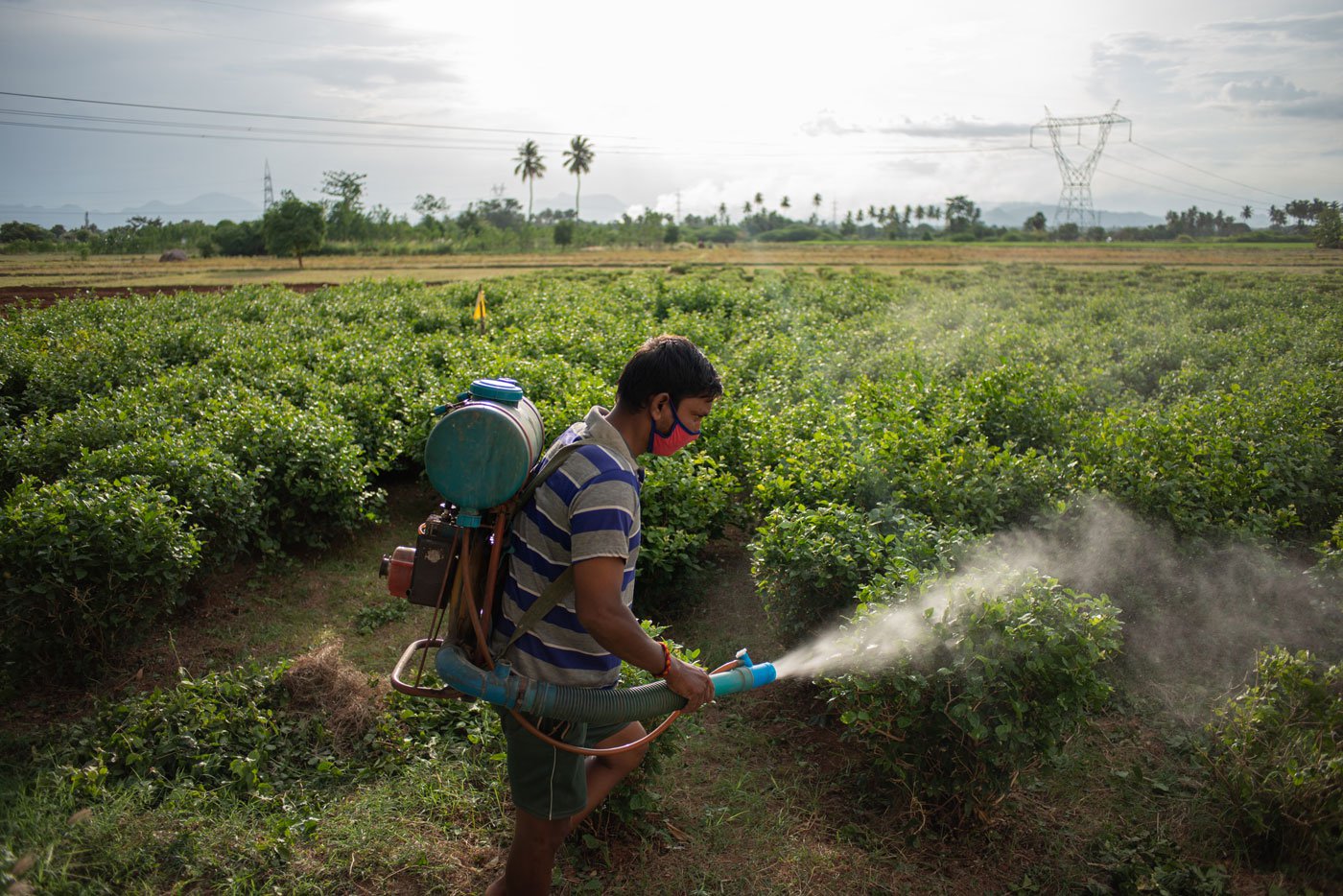
Pandi spraying his jasmine plants with a mix of pesticide and fertiliser
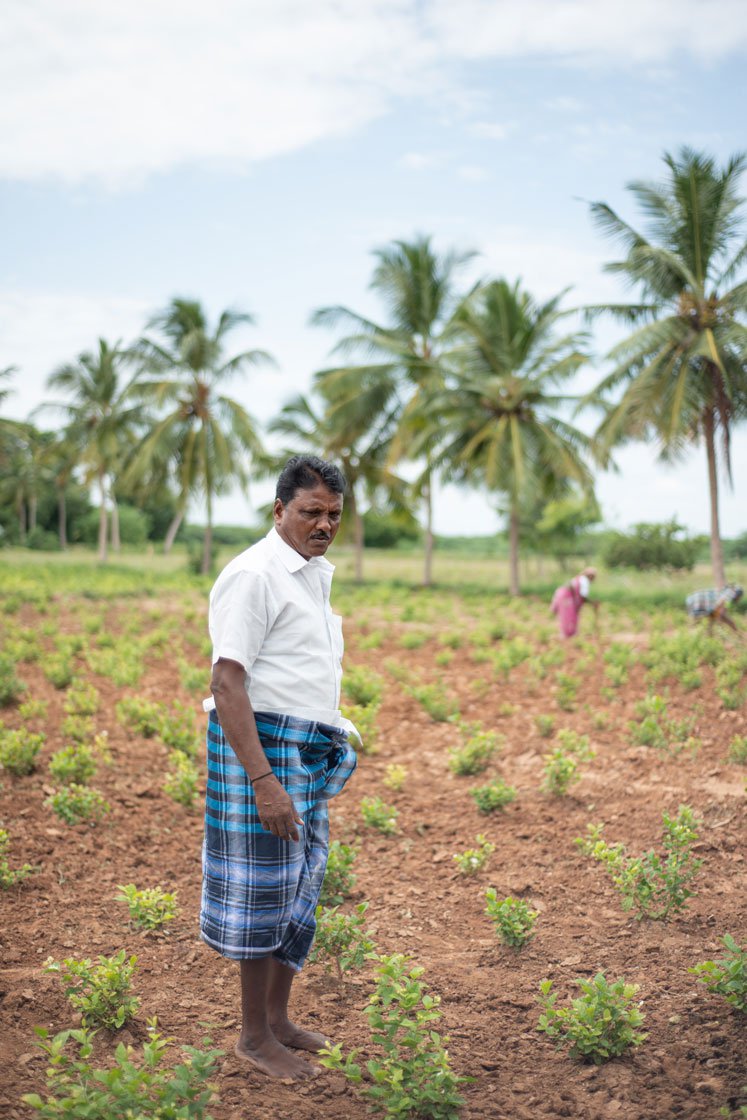
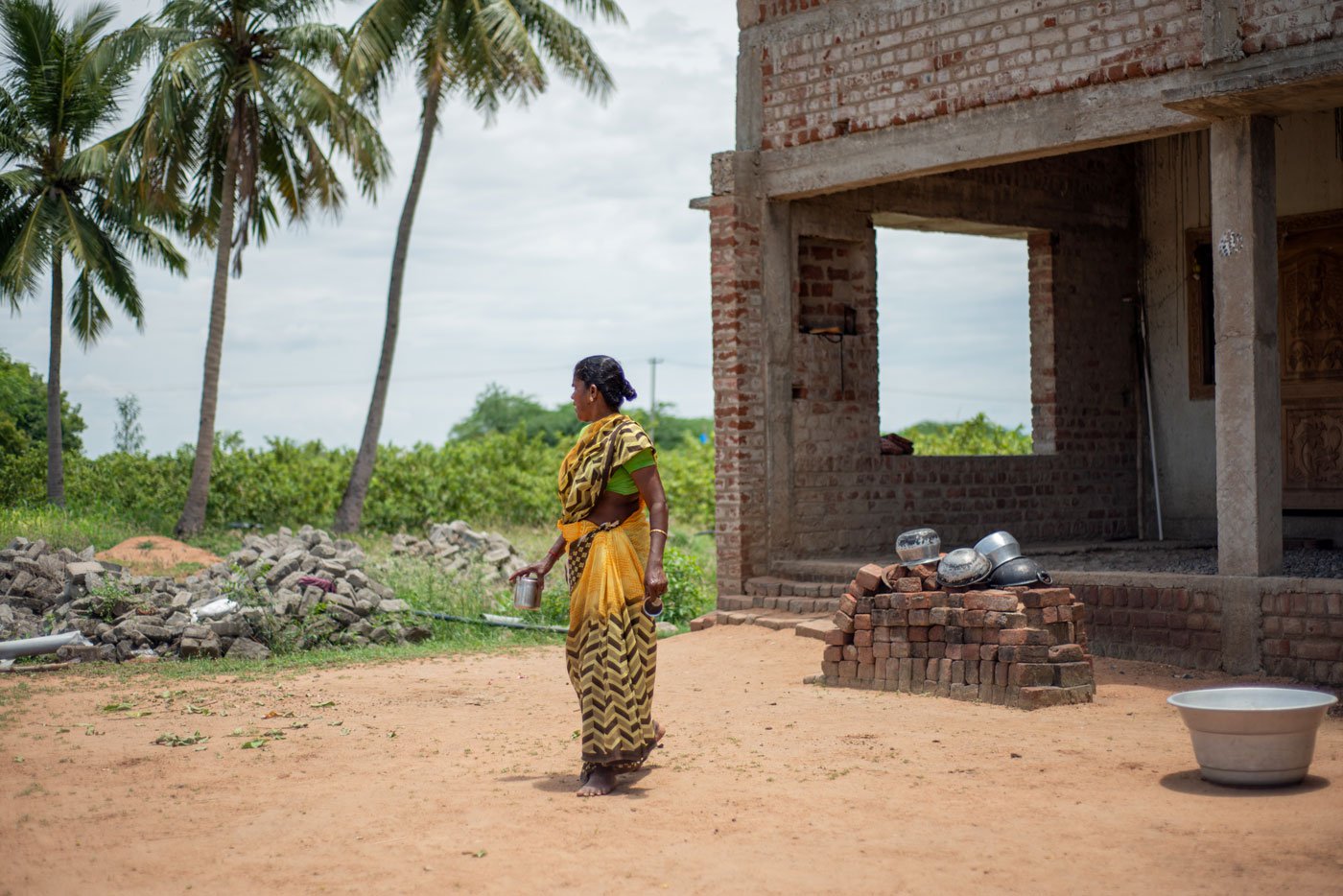
Ganapathy walking between the rows of his jasmine saplings. Right: Pichaiyamma in front of their house
He takes his flowers to Nilakkottai market, in the neighbouring Dindigul district, around 30 kms away. “In Mattuthavani – it’s great, don’t get me wrong – you sell it by the kilo. In Nilakkottai, you sell it by the sack. Plus, the trader sits nearby. He keeps a tab, and will give you an advance for unforeseen expenses, festivals, and sometimes to buy chemicals to spray the flowers.”
Spraying is key, Pandi says, changing into shorts and a striped t-shirt in his shed. Jasmine has many admirers. And it attracts many pests. Unlike Ganapathy, who has an in-house expert in his son, Pandi has to go to the shop and get the specific chemicals. He points to the used-up cans and bottles on the ground, and from inside his shed, he brings out the tank and the sprayer, and mixes Rogor (an insecticide) and Astha (a fertiliser) with water. It costs him 500 rupees to treat an acre once and he repeats the mix every four or five days. “You’ve got to do this in peak season and lean season. No choice…”
For nearly 25 minutes, wearing just a cloth mask across his nose, he showers his plants with insecticide and fertiliser-laced water. He walks between the thick bushes, the heavy contraption hung on his back, the powerful sprayer hitting every leaf and plant and flower and bud with a fine mist. The plants are as tall as his waist; the mist reaches his face. The machine is noisy, and a chemical fug hangs in the air. Pandi keeps walking and spraying, stopping only to refill the can, and off he goes again.
Later, after he has showered and changed back into his white shirt and blue lungi, I ask him about the exposure to chemicals. He answers me, speaking calmly: “If you get into jasmine farming, you just have to do whatever it takes. If you don’t want to [spray], you have to sit at home.” He presses his palms together as he speaks, as if in prayer.
Ganapathy says the same thing when we leave. He fills my handbag with guavas, wishes us a good journey, and bids us to come again. “Next time, this house will be ready,” he points to the unplastered brick house behind him. “And we’ll sit here and have a big meal.”
Pandi and Ganapathy, like thousands of jasmine farmers, have pinned their hopes and dreams on a little white flower, with a heady scent, and a hoary past, and markets where business is vigorous and volatile, and in five minutes, thousands of rupees – and kilos of Madurai
malli
- change hands.
But that’s a story for another day.
This research study is funded by Azim Premji University as part of its Research Funding Programme 2020.
